#onvideogames
Explore tagged Tumblr posts
Text
I have a lot to say about Super Princess Peach and Sexism
I have a confession. Princess Peach was one of my first “sexual awakenings”. No, wait, okay. I have to be REALLY honest. She was my first sexual awakening. There. I said it. I had a crush on a fictional character before a real person. She always had and always will have a soft spot in my heart ever since I first played Super Mario 64.


Nowadays, Princess Peach has been shat on in favor for Princess Daisy.

In our more enlightened age, people have forsaken the “classical view” of a princess that was seen in Princess Peach in favor of Daisy. Over the years, Daisy has been subtly marketed as the more tomboyish of the two. She’s peppy, she’s loud, she’s brown-haired because we need to take back the throne from the blonds, and she’s “the more fun one”.
Fuck that Princess Peach, amright? That hoity-toity dumb bimbo who keeps needing to be saved. This is the 21st century - down with stuck-up blonds! And meanwhile, I was there in the corner laughing nervously at this uproar and whispering, “I’ll never betray you, Princess Peach. They don’t understand you like I do.”
I get it though. We need to showcase a wider variety of what a princess acts like. All for it. Princess Peach stood for the stereotypical blond bombshell princess that Nintendo cashed in on.
Well, originally, she was red-haired, but that changed with the times in favor of blond. That’s the thing though! Peach became what the popular male psyche demanded and desired at the time!
Therefore, she became the target of contention for every woman who grew up failing to meet her standard. But now it tipped too far in one direction, and I can’t help but feel that we never learned our lesson.
It concerned me when female gamers seemed to learn to hate Princess Peach by practically drawing an X on her face a la Mean Girls and muttering, “She’s a bitch.” When I’ve played Super Smash Bros. with girls, one of them typically makes some scathing remark about Princess Peach. “What a whore.” “That bitch.”
“That blond bimbo.”
Yay. In reality, we fell into the patriarchy’s trap all along - women hating on women. When Super Princess Peach first came out in 2005, I happened upon it by chance in Best Buy when I was looking for something for my birthday. It was always a deep dark secret that I now openly admit. I fervently wanted a video game that starred Princess Peach ever since I was little. Super Mario RPG: Legend of the Seven Stars for the SNES was the closest thing at the time, but we all know how obscure that game became. And there I was, 15 years old, all red-faced at buying a stupid video game. When I approached my mom in the store to show her what I wanted, I felt like I was making a drug deal. I shifted my eyes around me to make sure I wasn’t being followed or watched. I murmured, “This one.” I was confident that she would go along. She doesn’t read much into these things. She mixes Nintendo games with PlayStation. She would just buy it and go.
But that time, she stared at the cover for a while and said aloud, “Is this right? Super Princess Peach? Are you sure this is for you?”
AUUGGGGH. MOM DON’T MAKE A SCENE HERE IN BEST BUY THIS IS WHAT I WANT OKAY? BYE. I said yes, and she further asked some questions like “Are you sure?” and “Is that a little kid’s game?” And I just gritted my teeth and mumbled something incoherent about it being just another Mario game. I finally got the game, and I was excited to play, and breezed through it in almost one sitting. At the same time, it was an awful game. Let me lay it out this way. This is the first time in Nintendo history that Princess Peach gets her own video game.
Right? It’s her BIG debut. And so. . . The game has her trying to retrieve the Vibe Scepter from Bowser, and place it back in its rightful place on Vibe Island. Without the Vibe Scepter, people’s emotions are out of control.
Are you sensing a theme yet?
No?
Let me go into more detail.
The gameplay requires you to tap into Princess Peach’s four emotions (Joy, Sadness, Anger, and Calm) to get through obstacles. So, say you need to grow a flower, you make her sad and she cries so much that it---I fucking can’t even continue writing this. You get the picture.
So there I was playing this game in my bedroom and realizing how horribly sexist it was. I had so many conflicting feelings about it (maybe THAT’S what they were trying to do?) because on one hand I wanted to support my first waifu but on the other hand this was laughably dumb and sexist. I played through to the very end anyway. The other non-emotion-based abilities were enough to keep me going. That was really what I wanted. I just wanted a Mario-like game starring Peach where she used her umbrella and shit, maybe did a dance, and then saved the day and winded down with some tea in the final cutscene. Like you know Super Smash Bros. Brawl in the Subspace Emissary cutscene where she meets Fox? She’s sauntering down the Halberd while a literal dogfight is happening in the sky above her, completely unperturbed.

(Peach just not giving a fuck.)
And like her only reaction is a little “Oh!” as she protects herself from the wind as if it were nothing more than a little squall. There’s some sweet action of Sheik breaking into Fox’s cockpit, and the two jump down to the Halberd and run at each other until Peach raises a hand and offers tea to stop the conflict.

That is the Princess Peach I want to see, the one I think is rare in media - a conventionally feminine action/adventure protagonist.
Lord knows we have enough femme fatale assassins with a dark past.



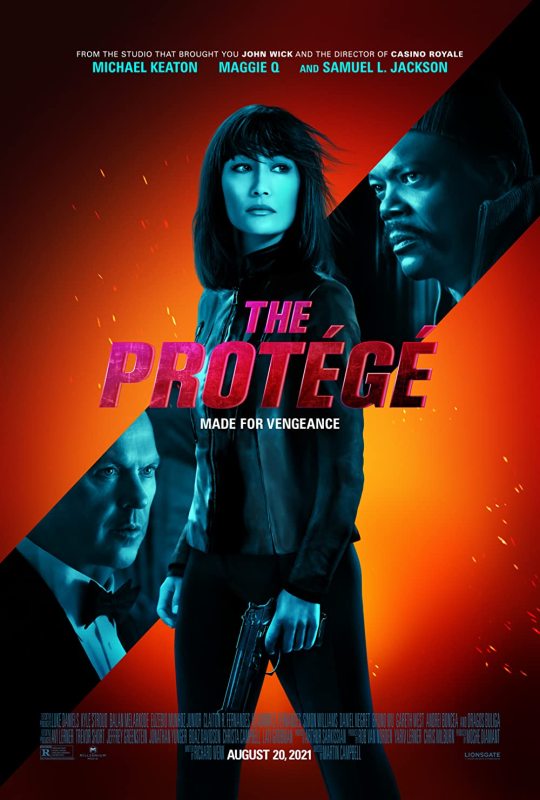
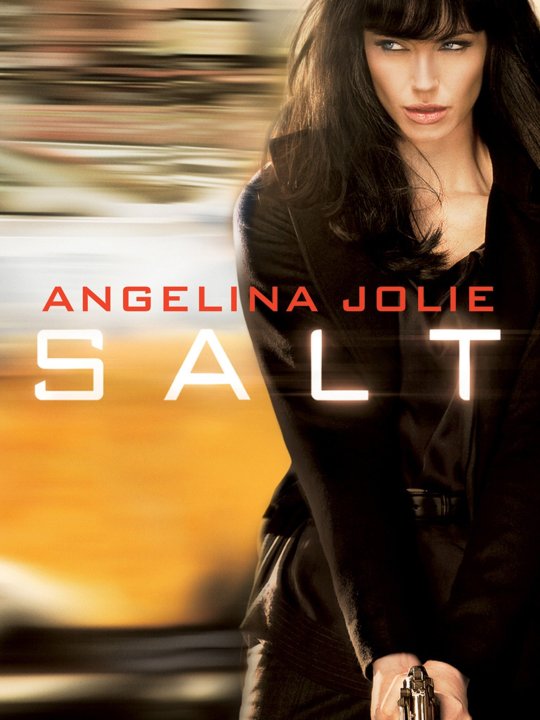
The femme fatale assassin is seemingly the only acceptable female protagonist in movies. Why? Because it’s a male fantasy. The only way men are going to see a movie about a female action hero is if she acts more masculine. And it’s a trap. It’s a fucking trap. We dug ourselves in a hole again and can’t see the point three inches from our fucking eyes. You rarely see a female action protagonist who shouts “Ew!” when she sees a bug, or who loves to collect pins, or who has a thing for baking, or who doesn’t have some terrible trauma as a backstory. You never see a female action hero who is awkward around men or has no idea how to seduce someone. The moment a female character like Princess Peach can star in her own game, the developers play into female stereotypes of emotions. They market the game for girls by tying it to emotions, in a world where we are still afraid to treat the female lead equal to the male lead. THAT is the problem I have with Super Princess Peach. I brought this up once in a certain video game forum a long time ago. The reception wasn’t very well met. I knew I shouldn’t have opened that can of worms but I fucking did it anyway. Just couldn’t shut up about it. Goddammit, Eddie, you should have shut up. You should have shut up. But no, I couldn’t. We’re doing this. We’re having this conversation. It was just burning on the tips of my lips. “Hey, isn’t Super Princess Peach a bit sexist?”
The surge of counter-arguments included things like “Well it’s not about Peach being emotional, it’s the island and the island is out of control so everyone’s emotions are out of control.” To me, that sounds awfully like the developers tried really hard to find an excuse to incorporate female stereotypes about emotions. It’s just so obviously contrived. I fervently wanted someone to see my point. I didn’t go out and about just starting arguments this way. I kept waiting for the right opportunity to spring into action.
The second and final chance popped up on Facebook. This was still a long time ago. Maybe some six-ish years ago? I don’t even remember how the debacle started but I think someone brought up female protagonists in video games, and I brought up the unfortunate failure of Super Princess Peach and how it was sexist. I was immediately torn apart. Immediately. This time was different though, because the person who tore me apart was a woman. I thought, “Dammit, Eddie, maybe you were wrong the whole time. Maybe I AM the bad guy.” Not only did the dude bro Pr0 GaMeRs disagree with me, but now a female gamer too.
“You are dangerously belittling women's’ emotions”, she told me. I cringed so hard at myself and wanted to just crawl up and die. It was such a stupid argument and I honestly was ready to die. I feel SO dumb admitting it but I was just SO into that argument. I had officially died on the hill that I so desperately wanted to defend and nobody - fucking NOBODY - was on my side. I went through a dark time (of like maybe a week) and dove into in a dark place (my bedroom). I questioned my morals and my goodness. Was it sexist to dislike the game? Was it not sexist? Was it sexist to equate the game with the stereotype that men think of women as PMSing all the time? Was it not sexist to identify the stereotype? Because aren’t the makers of the game trying to weasel their way into applying their beliefs about women and what they think would attract female gamers? Maybe it’s only sexist in the metaphysical context? Maybe this is what the patriarchy is all about - trapping you in an endless pandemonium where you can never be sure if you are advocating for freedom or oppression. It was a never-ending soul-crushing conundrum that I couldn’t break free from, constantly philosophizing and moralizing.
But look - Nintendo marketed Super Princes Peach towards girls in hopes of drawing them in to what they think they could relate to. It sold well, yeah, but it wasn’t like large swaths of girls in the gaming community suddenly exclaimed and said “FINALLY! THE GAME FOR US!”. Why? Because it’s fucking patronizing, that’s why! Girl gamers just want to play the same shit that guy gamers play. Legend of Zelda, Final Fantasy, Call of fucking Duty. I had this piece in my drafts for well over two years, afraid to post it.
Fuck it.
Here it is. Anyway. It’s 2022 now and apparently most of us can agree that yeah - Super Princess Peach was pretty fucking sexist. I hate you all.
#princess peach#super princess peach#nintendo#mario#onvideogames#video games#luigi#super smash bros. brawl#black widow#feminism#meninism#something something#gender#politics
15 notes
·
View notes
Text
Describing each Final Fantasy game with an unrelated image or gif
Final Fantasy

Final Fantasy II

Final Fantasy III

Final Fantasy IV

Final Fantasy V

Final Fantasy VI

Final Fantasy VII

Final Fantasy VIII

Final Fantasy IX

Final Fantasy X

Final Fantasy XII

Final Fantasy XIII

Final Fantasy XV

#final fantasy#final fantasy ii#final fantasy iii#final fantasy iv#final fantasy v#final fantasy vi#final fantasy vii#final fantasy viii#final fantasy ix#final fantasy x#final fantasy xii#final fantasy xiii#final fantasy xv#video games#onvideogames
168 notes
·
View notes
Text
ScottyMcGeester Plays Every Final Fantasy Game*
*Okay, all the main games except 11 and 14 since they are online only, and also no spinoffs or sequels.
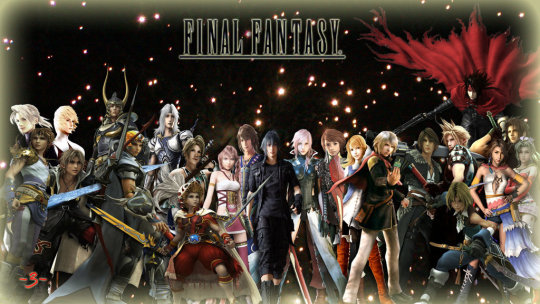
THE INTRODUCTION
Years ago, I had a goal to finish every Final Fantasy game. As of December 30, 2020, I finally reached that goal. I originally started posting these reviews way back in 2017 on VGF(VIdeo Game Forums), and posted one review after another as I completed each game. I had already finished a few before I started reviewing the series, such as Final Fantasy I, II, VI, IX, and X.
Final Fantasy X was my very first Final Fantasy game, way back when it first came out on the PS2. It took me years to finish that game, mostly because I was still a novice at RPGs and I didn’t quite know what I was doing. Still, the world and concepts of Final Fantasy gripped me. As a sci-fi/fantasy writer, they inspired tons of elements in my stories. The series spans a multitude of genre-bending stories – sci-fi, fantasy, some steampunk, modern fantasy, space, traditional fantasy with knights in armor – and a whole lot of crystals. I wrote these reviews as if you have no idea what Final Fantasy is – whether you are a gamer or non-gamer. This first post is a general introduction to the series as a whole, but even if you are a die-hard fan already, there are some things that I explore that I hope you'll find interesting. What is Final Fantasy? Final Fantasy is a roleplay video game series that started back in 1987. The first game was reminiscent of Dungeons and Dragons, where you could choose one of six roles for a team of four: White Mage, Black Mage, Red Mage, Thief, Monk and Warrior. Square, now known as Square Enix, developed the game. A legendary rumor about the title “Final Fantasy” comes from the story that they were on the verge of bankruptcy. They only had money for one more game, a fantasy game. They dubbed it “Final Fantasy.” This apocryphal story is nowhere near true. Square had made video games before and they didn’t do well, but the company itself wasn’t on the verge of bankruptcy. What happened was that the developer, Hironobu Sakaguchi, had planned to retire. He didn’t see any foreseeable future in video gaming with Square’s mediocre performance. He wanted to make a fantasy game and dubbed it “Final Fantasy”, since it was to be his personal last work. He also wanted the game to be abbreviated as “FF” – they originally had “Fighting Fantasy” in mind but that name was already trademarked by a board game. Final Fantasy initially sold 400,000 copies in Japan and became and instant hit. Nintendo of America approached Square to release a localized version for the states. Final Fantasy became far from Sakaguchi’s last game. What’s Final Fantasy about? Every main Final Fantasy game has a new story with new characters and even new gameplay. Some games have direct sequels and are recognizable with a subtitle, or an additional number following a dash. For example, there is Final Fantasy VII, and the direct sequel to that Dirge of Cerberus: Final Fantasy VII. There's a direct sequel to Final Fantasy X titled Final Fantasy X-2. But even though each Final Fantasy game is different, there are still central elements that make them a Final Fantasy game. You can’t just write up a random fantasy story and slap the Final Fantasy name on it. The following elements are what make a Final Fantasy game. Some are obvious while others not so much. Chocobos:

Chocobos were first introduced in Final Fantasy II, but have been present ever since. They are cute, large birds that the characters often ride across fields or sometimes call into battle. They have practically become the mascot of the series. Moogles, Cactuars and Tonberries – oh my!
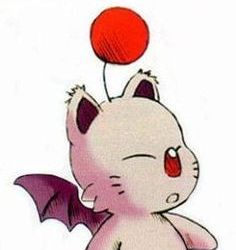
Moogles (pictured above) are telepathic creatures that help the players, or sometimes they can be a playable character. They debuted in Final Fantasy III.
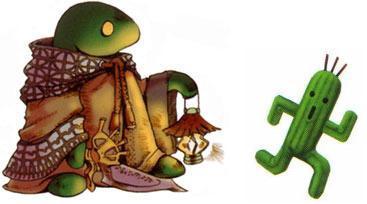
Cactuars (right) and Tonberries (left) are cute, unassuming enemies that are actually highly dangerous, killing you in one shot if you are not careful or fast enough. The former debuted in Final Fantasy VI while the latter debuted in Final Fantasy V. Summons:
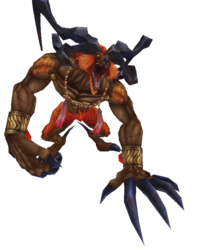
Sometimes they go by different names, like eidolons or espers. Summons are massive, fantastic beasts that you can call upon to aide you in battle to fight the enemy. Summons became a staple ever since Final Fantasy III. In some games, they are merely there to call into battle, while in other games they are central to the story. Airships:

Airships have been present since the first game. They are massive boat-looking airplanes. In the more recent games, airships look almost like spaceships.
Cid:
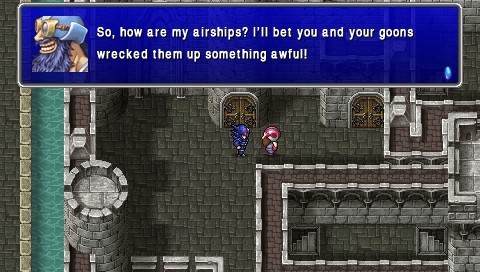
With the exception of the original Final Fantasy (except in later remakes), every game has a character named Cid. Cid is typically the character who owns an airship.
Items and Magic Spells:
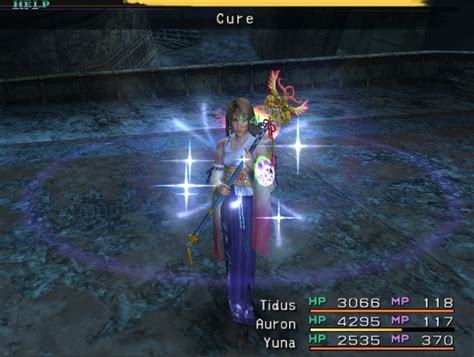
Each game shares virtually all the same items and magic spells. Antidotes. Eye drops. Maiden's kiss. Holy water. Phoenix Down is well-known for reviving knocked-out characters in battle. The spells follow a hierarchy of levels. For example, Cure is the basic spell to heal somebody. The second level spell for healing is Cura. Then Curaga. Then finally Curaja. Most other spells follow the same format. The same high-level spells also frequently appear throughout the games, such as Holy and Flare.
Crystals:
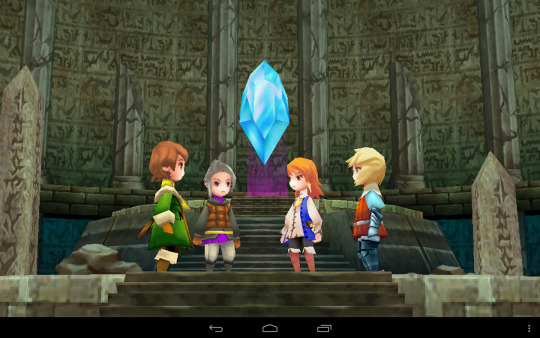
With a few exceptions, crystals appear in nearly every game. They often serve as plot devices, whether they be the force that protects the planet or powerful objects coveted by the enemy. They also oftentimes have a consciousness of their own, communicating with the characters and calling them to their destiny.
Mythological References:

Final Fantasy is riddled with mythological references. Many summons and creatures take the names of mythological creatures or deities, such as Shiva, Bahamut, Leviathan, Behemoth, Odin, and Ifrit. Certain villains share the names of mythological figures or they are derived from certain mythological concepts, such as Gilgamesh and Sephiroth. Many of the games have legendary weapons you can find near the end of the journey. These are typically named after legendary Japanese figures, such as Masamune and Yoichi, or other world mythologies, such as Thor’s hammer Mjolnir. Saving the World:

Final Fantasy isn’t about saving a particular princess, or person for that matter. The ultimate goal is to save the entire world, or even the very fabric of reality. Evil spreads in many ways, such as a sealed darkness trying to break free, empires with ambitious goals, villainous subordinates who pull the strings of politics, or empires destroying the environment. Typically, the main cast consists of characters from all walks of life. They all have to learn to work together and get through their personal struggles to save the world. Existential Crisis (or Startling Revelation):
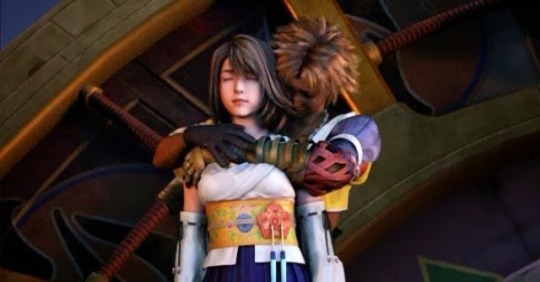
By the time you reach the third act of a Final Fantasy game, some startling revelation forces the characters to question their very existence. A villain is revealed to be a hero’s family member, a main character realizes they're a clone, another realizes that they cannot live without magic, etc. Typically, the main character questions the nature of their soul, if they die like regular beings and become part of some greater life force, or blink out into oblivion. Whatever the revelation may be – it serves as a final crisis that the characters have to overcome. The Descent into Hell:

Every third act of a Final Fantasy game ends with what I like to call a “descent into hell”. The final dungeon is always some kind of bizarre world. In Final Fantasy II, you literally descend into hell to fight the Emperor. Throughout the series, hell is more metaphorical. The final dungeons can be a massive, sprawling tower or dreadnought, or a strange dimension that appears to have no rhyme or reason. Sometimes I'm reminded of M.C. Escher’s work, “Relativity”, or sometimes it reminds me of some cosmic horror featured in the Cthulhu Mythos. These final dungeons can be inter-dimensional rifts between space and times, pockets in reality, subterranean depths, insane worlds that the villain created, and worlds of darkness. (Final Fantasy IX's Memoria)
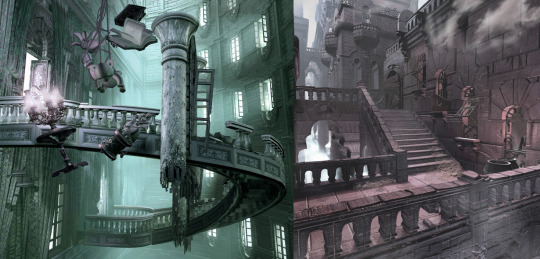
(M.C. Escher's “Relativity”)
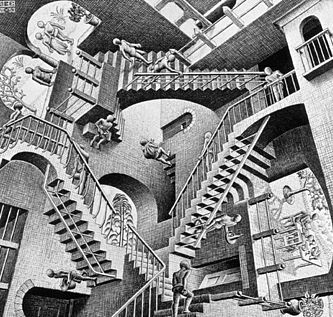
These stylistic approaches for the final dungeon represent the oncoming battle with the forces of chaos. Fighting God:
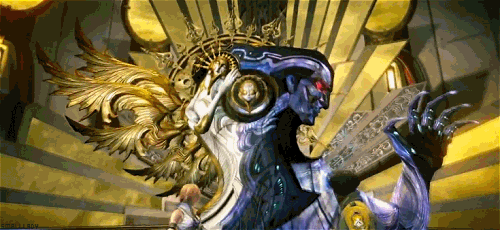
After venturing through the surreal and hellish final dungeon, you face the main villain. The main villain always achieves godlike status or the characters actually have to defeat a god in order to save the world from its oppressive reign. Many stories appear to throw in a last minute ultimate god who was pulling the strings of the plot the entire time. The purpose of dealing with gods and goddesses represents the characters’ desire to control their own fate and alter their destiny. Most of these bosses are strange and grotesque, definitely getting a Cthulhu vibe from them. I looked at them and thought, "Christ, what the hell is THAT supposed to be?"

It always feels like THE final fantasy:
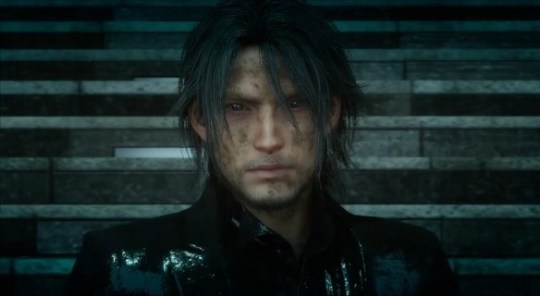
Each game, no matter what happens or how it happens, feels like the be-all-end-all of its story – its fictional universe. Direct sequels were unheard of until Final Fantasy X-2, which while fun, was wildly different in tone from the original game, and critics pointed out that it ruined the finality of Final Fantasy X. This is one reason why I think direct sequels to Final Fantasy games fail – what else could the main characters possibly face that is more dangerous than the one they just encountered? Anything else would feel like child’s play to them. NOTABLE PEOPLE Aside from the characters, stories and games themselves, the people behind the series have achieved legendary status. Nobuo Uematsu:

The original composer of Final Fantasy. Uematsu single-handedly scored the first 9 Final Fantasy games. Uematsu surprisingly never had any formal training in music – a trait that would ostracize any composer, such as Danny Elfman. I find that the those who haven't had any formal training usually break the mold with music. Uematsu started working for Square at around 25 for the first Final Fantasy game, starting out with nothing and never suspecting his job would lead him where he is now. His music is unique for incorporating elements of classic and progressive rock, specifically in the battle themes. Uematsu’s themes for each game have achieved instant recognition in the gaming world, as recognizable as the theme to Star Wars or James Bond. Tetsuya Nomura:

Tetsuya Nomura is a video game designer and director who started at Square in 1990. He rose to prominence when he was given full control of designing the characters for Final Fantasy VII – arguably the most popular Final Fantasy game to date because of its characters: Cloud Strife, Tifa Lockhart, Vincent Valentine and Sephiroth. Nomura went on to create more legendary characters for Final Fantasy VIII, X and XIII. Yoshitaka Amano:

Amano is the artist whose work is most known now in Final Fantasy. He has done concept art and design for every game in the series. His style is instantly recognizable. He has also drawn for many anime shows, comics and mangas, such as Vampire Hunter D and Sandman: The Dream Hunters.
And last but certainly not least - THE MUSIC Final Fantasy has left its mark in the musical soundtrack of video games. Each game more or less shares three of the same memorable tracks.
The Prelude:
youtube
The Victory Fanfare:
youtube
The Final Fantasy Main Theme:
youtube
THE REVIEWS
Each review I post will critique major aspects of each Final Fantasy game, such as its gameplay, graphics, story, and music. Today is currently January 3, 2020 (technically the 4th when I post this because it’s past midnight), and I will be posting one review per day so as to not lose my sanity editing and formatting everything at once here. So look forward to the very first review tomorrow starting with the very first Final Fantasy game.
#final fantasy#final fantasy v#final fantasy vi#final fantasy vii#final fantasy vii remake#final fantasy xv#final fantasy xvi#tifa loc#cloud strife#sephiroth#nobuo uematsu#video games#sony playstation#playstation 5#final fantasy x#onvideogames
119 notes
·
View notes
Text
Final Fantasy IV Review
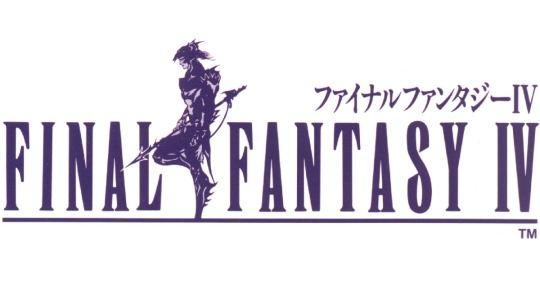
Year: 1991
Original Platform: Super Nintendo (Originally introduced to Western audiences as Final Fantasy II, since the real II and III were not released outside of Japan at the time.)
Also available on: Nintendo DS, PSP (Final Fantasy IV: The Complete Collection), GameBoy Advance, Playstation One (Final Fantasy Chronicles), Steam (DS remake)
Version I Played: PSP
Synopsis:
Cecil Harvey is Batman a dark knight who follows orders from King Baron. The king tasks Cecil and his partner Kain with taking the crystals from the surrounding nations and cities. Cecil questions his king’s motives, leading to the revelation of a grand conspiracy. Cecil then goes on a quest to right his wrongs.

Gameplay:
The novel feature of this game was the ATB system – Active Timed Battle. This means that instead of you and the enemy waiting for your respective turns one at a time, each character takes their turn according their respective speed. One character may be slower than the other, so they will take longer to be able to perform an action. Basically, with ATB, if you wait too long to think about what to do on your turn, the enemy can hit you - JUST AS IF YOU WERE REALLY BATTLING IN REAL LIFE.
While Final Fantasy IV introduced ATB, it did not utilize the ATB gauge in actual battles. The ATB gauge is a visual bar during battle that shows your character’s speed. Whenever it’s filled, your character can perform an action. The gauge itself was first seen later in Final Fantasy V. Later remakes of Final Fantasy IV displayed the ATB gauge. Some configuration options were introduced later to give you the ability to change the battle system to active or wait. Putting it on wait would allow the timed battle to pause while you thought about what to do during your move.
Final Fantasy IV forsakes the customizable Job System and introduces characters with individual jobs. Kain is a dragoon, who can jump in the air and deal destructive damage. Rydia is a summoner. Yang is a monk. Etc, etc.
The Super Nintendo and PSP versions are more or less on par with each other in terms of difficulty. The Nintendo DS remake is really hard. Like REALLY hard. Like “throw-your-DS-across-the-room hard”. I myself have had trouble finishing it.
Graphics:
I haven’t played the original SNES version of Final Fantasy IV, but judging by the images it appears to be in this liminal state between NES and SNES. Not quite NES but not quite utilizing the full power of the SNES either.

The PSP version is somewhat reminiscent of the Anniversary Editions of Final Fantasy and Final Fantasy II, but it still has its own flair that outshines them.

Final Fantasy IV DS is pretty much a 3D remake in the same vein as Final Fantasy III DS, with an awesome opening FMV. The in-game cutscenes however now have VOICE ACTING.
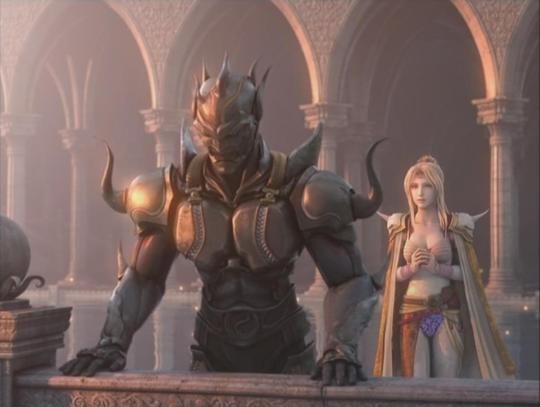
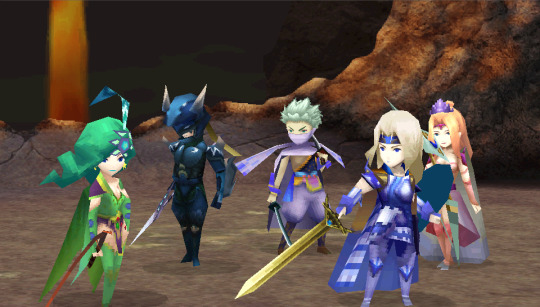
Now, the PlayStation One version has a FMV sequence that hasn’t aged well at all. We’re talking worse than the Final Fantasy and Final Fantasy II FMV sequences from PlayStation One. I can’t even find a good snapshot from Google Images, probably because nobody wants to look at them ever again. You can find it on YouTube though.
Story:
Final Fantasy IV is well known for being the first GOOD story in a Final Fantasy game. Cecil’s personal journey of redemption rung in the minds and hearts of audiences. There’s a nice balance of focusing on individual struggles and an epic adventure to save the world.
The cast of characters is pretty wide. Like Final Fantasy II, several secondary characters come and go. There is one difference but I don’t want to spoil anything. I guess the least I could say is that Final Fantasy IV subverts what to expect after having played Final Fantasy II.
Like Final Fantasy III, Final Fantasy IV includes crystals as an important plot device. This time they hold enormous power that the villain Golbez wishes to obtain for nefarious means.
While the story is infinitely superior in storytelling to Final Fantasy II, there are still some silly moments. I could best describe the bulk of the story as “Cecil and friends are on a race to capture each crystal around the world but something always gets in the way at the last minute.” While for the most part the story is done well, there are seemingly cartoonish moments involving random trapdoors and bewitched dolls. One particular moment I found myself thinking, "So you're just going to stand there while he does that?"
But I think the most admirable part of the story is how they approach Cecil and Rosa’s romance. While most RPGs, especially today, try to hash in a childish romance subplot, Cecil and Rosa are that rare couple that are already together at the beginning of the game. Their love is tested throughout the story.
The most popular quote from this game involves a complicated matter of translation. Western releases of Final Fantasy games (and Japanese games in general) often had awkward translations. “You spoony bard!” is one such awkward translation that originates from this game.
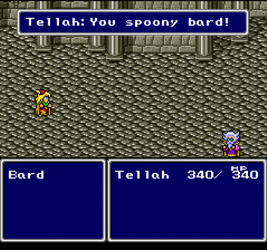
The character who spoke this line, Tellah, is arguing with the character Edward. The translation came out at “spoony” due to the Japanese writers believing it was still used today in English. It’s an archaic term meaning “enamored in a silly or sentimental way”. It technically fits, but clearly, nobody uses that word anymore, and players laughed at how nonsensical it seemed.
While I don’t want to spoil why Tellah is angry at Edward, the scenario in question is dramatic, and so Tellah saying “idiot” or “moron” wouldn’t quite suffice. The original Japanese word that Tellah uses is “kisama”, which in the given context is akin to telling someone they are a “son of a bitch” or “bastard.” Western releases, especially North American, were very often censored and demanded less or no profanity.
Overall, Final Fantasy IV is the first notable story in the Final Fantasy series, way better and much more original than Final Fantasy II.
Music:
With the Super Nintendo, Uematsu was able to play with more sounds. The drumming that Uematsu had wanted in his battle themes is more apparent. He also added an accompaniment to the Prelude. The main theme of Final Fantasy IV is scattered throughout the score, just like a motif in a movie score. The main theme is the map theme, and I like how, for example, the theme changes to a different beat when you venture into the underworld. The main theme even pops up in the final battle, which to me is awesome because it illustrates the heroes collectively trying to banish evil.
In one interview with Uematsu, he stated he was a huge fan of Elton John. For some reason, after I read that, I totally see the main theme of Final Fantasy IV having an Elton John vibe, especially in the epilogue with the drums and the bass.
Red Wings, which is the theme for Baron’s elite air force of the same name, is notable for its unorthodox time signature. I swore I read that somewhere years ago but now I can’t find it, so if someone happens to come across it – let me know. The theme for the Red Wings sounds both heroic and sinister, referencing Baron’s underlying motives and Cecil’s dual nature.
Cecil and Rosa’s love theme is actually taught for schoolchildren in Japan as part of their music curriculum.
Uematsu pretty much matured at this point, in my opinion.
Notable Theme:
There are so many but my personal favorite is “Dreadful Fight”, a.k.a “Battle with the Four Fiends”.
youtube
I’ll also highlight the “Theme of Love”, because it needs to be out there as the first love theme for the Final Fantasy series.
youtube
Verdict:
Hands down, the perfect place for a beginner. You want to start getting into Final Fantasy? Start with Final Fantasy IV. The gameplay is easy to pick up. The story is simple and straightforward compared to the rest of the series but still effective. To those having played the later games first, it could seem trite. Unlike most of the Final Fantasy games, the different re-releases can be quite offer a different experience due to the translations, graphical changes, and differences in difficulty. At the end of the day, I would say any 2D version is fine, the best is probably the PSP version, but save the DS remake for later, since it is more difficult.
Direct Sequel?
Yes. Final Fantasy IV: The Complete Collection was released on the PSP in 2011. This is the version that I played. Square created two sequels for that collection: Final Fantasy IV: Interlude and Final Fantasy IV: The After Years. I haven’t played them myself yet, but there is criticism surrounding their stories, which apparently pale greatly in comparison to Final Fantasy IV.
By the way, the PSP version starts by showing the new FMV opening to Final Fantasy IV: The After Years, not the one shown in Final Fantasy IV DS. That’s a minor change but it really irked me, because the sequel’s FMV opening therefore spoils some of the story if you never played it before. I guess they wanted to distance themselves from Final Fantasy IV DS. Even so, why not just play that opening when you select The After Years?
#final fantasy#final fantasy iv#cecil harvey#rosa farrell#nobuo uematsu#square enix#onvideogames#video games#rpg#video game rpg#fantasy
39 notes
·
View notes
Text
Final Fantasy VII Remake Review

Year: 2020
Platform: PS4
I finished this game shortly after posting all my main single-player series Final Fantasy reviews. I was still digesting it and thinking about it to put together my review.
Synopsis:
The Shinra Electric Power Company rules over the city of Midgar, and the eco-terrorists AVALANCHE stop at nothing to try and prevent the life essence of the planet from being used as energy. Barrett, leader of AVALANCHE, hires a mercenary named Cloud Strife for their bombing mission on a Shinra Mako Reactor. Cloud doesn’t care much for the greater cause and only wants his pay. But then, after a mission goes awry, he meets Aerith, a flower girl who is the descendant of the Ancients. He quickly finds himself wrapped up in the greater conflict against Shinra.
Gameplay:
Final Fanatasy VII Remake has one of the best gameplay styles of any Final Fantasy game. It’s that good. It seems like after all these years, this is what Square really wanted to do. Since this was released after Final Fantasy XV, it’s pretty much the successor to its gameplay. While Final Fantasy XV has you more or less spamming the attack button with occasional spell casting and item usage, Final Fantasy VII Remake has you much more involved with the Materia system, abilities, and guarding/evading. One notable example is that Final Fantasy XV always told you when you should guard in order to counter, but Final Fantasy VII Remake has you figure that out on your own.
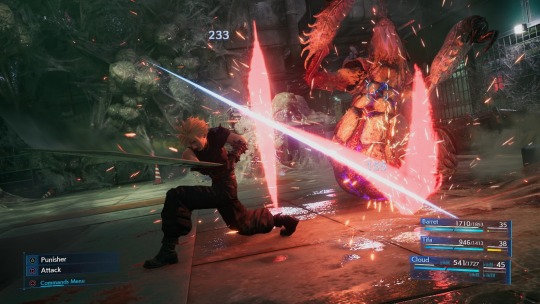
The abilities are so goddamn flashy and cool during gameplay. Tifa’s moves are quite possibly the most awe-inspiring.
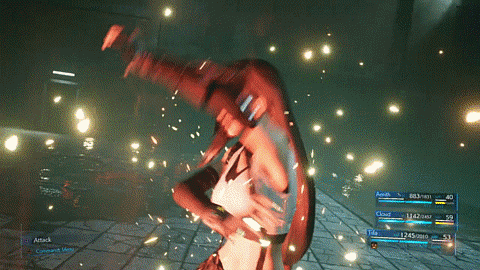
My only complaint is locking onto the enemy during battle. You have to press down on R3 to lock onto an enemy, and I sometimes found that jarring with the camera controls. Sometimes I accidentally disengaged from an enemy and missed an attack. Since your moves are dependent on an Active Time Battle system, you can waste a turn if you get hit while conjuring a spell or taking out an item. That sometimes made me go “REEEEEEEEEEEEEEEEEE!”. But in the long run, those were very small gripes. The battles are so much fun.
Since the game follows only the Midgar portion of the story, it’s linear. But you reach sections where you are free to roam around and do sidequests before continuing with the main objective. I’m sure the later releases of the remake will feel much less constrained. But this remake does a good job at expanding upon Midgar without feeling too redundant.
Graphics:
Jesus Christ. This game is gorgeous.

Both in-game graphics and pre-rendered cutscenes. The switch between a pre-rendered cutscene and in-game cutscene has become much more seamless than ever before.
If you remember my Final Fantasy XV review, I mentioned how NPCs and other in-game animations seemed stiff and stilted. Final Fantasy VII Remake takes steps to remedy that. Characters have more fluid movements and everyone’s lips move a lot more. However, lip movements can come off as awkward. My friend was watching me play, and during one in-game cutscene they said “Something looks weird with their lips.” At times, lip movements seem too dynamic when the character is standing relatively still, which comes off looking like Mr. Ed the horse trying to talk.
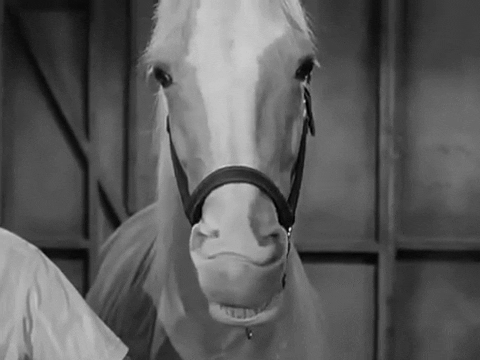
Despite those small awkward things, the rest of the game is extremely polished. Remember how blocky Final Fantasy VII was? We now finally see these characters and the world of Midgar brought to life in beautiful HD graphics.Like holy shit. Everyone looks so beautiful.
Before I played this game, I was a Tifa stan, but now, ho man, they made Aerith so much more appealing.

SO.
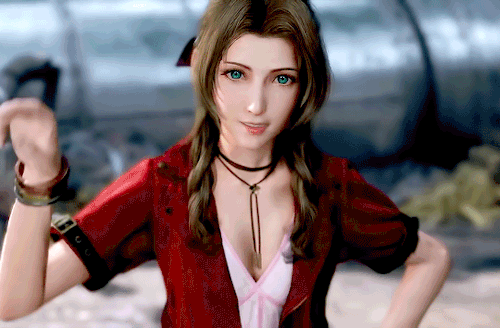
MUCH.
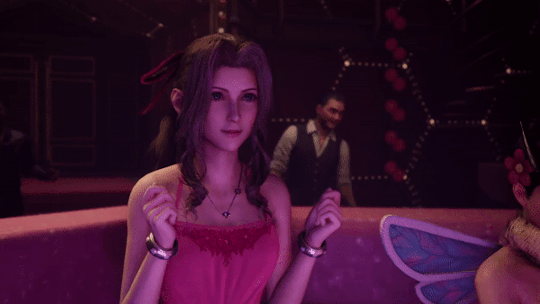
MORE.
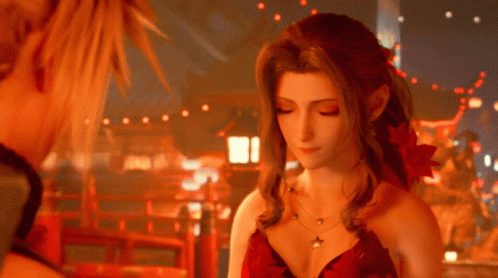
APPEALING.
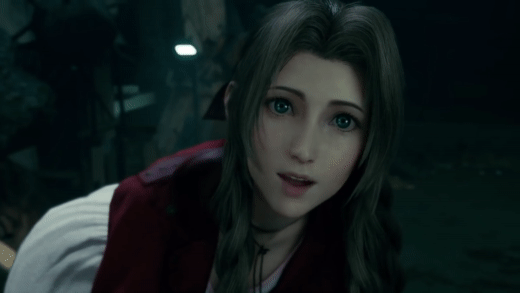
And Tifa shines better than ever. I’m very tempted to just gush about her but here is just a couple enticing gifs.
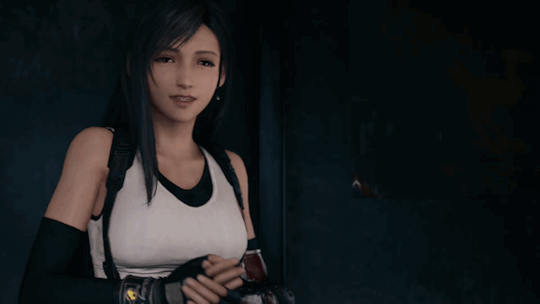
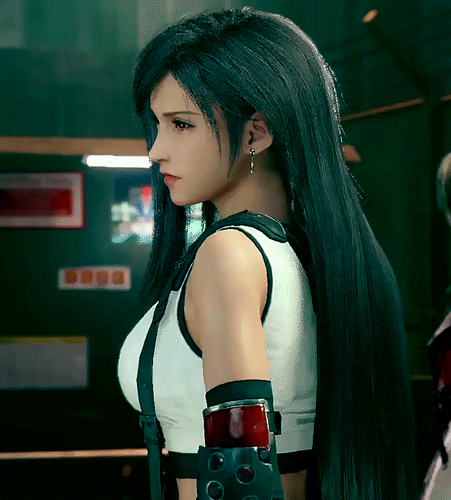
Imagine playing this game and still thinking gamers are oppressed.
Story:
Final Fantasy VII Remake follows from the start of the original game up until the party leaving Midgar. Square plans to release the rest of the remake later.
I have to say, they made the story a lot more engaging than the original. That may seem like blasphemy, but the dialogue and voice acting was just so damn good. Some of my favorite moments included the banter between Aerith and Cloud. Like I said, I wasn’t into Aerith that much until I played the remake. She’s just so damn cute and charming. One of my favorite parts was when she said, “Shit” and almost fell, after mentioning how she didn’t need help climbing a ladder. Her voice is so lovely and amusing to listen to. The growing romance between her and Cloud doesn’t come off as forced or cringey, because we now spend so much time with Aerith.
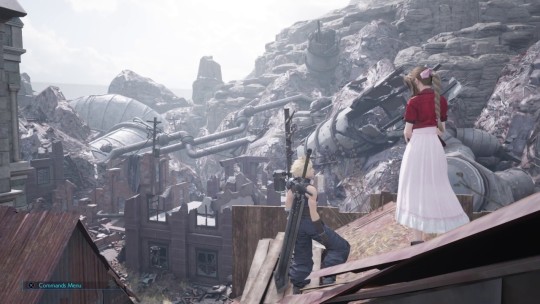
Biggs, Wedge, and Jessie have much more important roles in the story. This gives us a greater sense of Avalanche as a ragtag group.
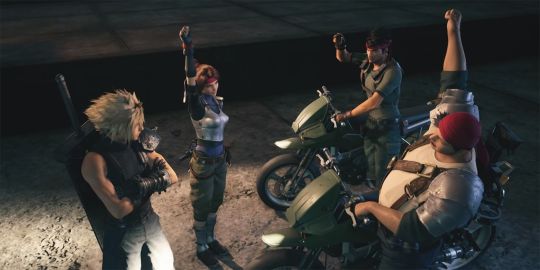
Entire chapters focus on them, especially Jessie. I cringed a bit at Jessie to be honest, despite her popularity. She now comes off as a copy of Aerith in the sense that she comes on strong to Cloud. But really strong. Like “I want that D right now” strong. Cloud has officially become your usual anime boy who is good at everything that can make any woman magically fall in love with him. So that whole thing made me roll my eyes.
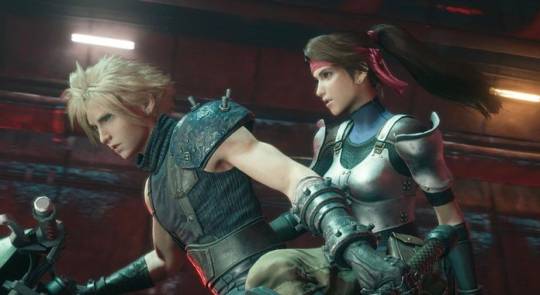
There are some new characters inserted, such as the SOLDIER Roche. I thought they were going to do more with him but, apparently not. The new characters can be a bit “meh”, such as Chadley. Johnny isn’t a new character but may as well be since his role is so expanded. He was probably the most annoying, constantly calling Cloud “bro”. That gave me some bad flashbacks of Prompto’s modern-speak in Final Fantasy XV.
The remake adds a certain new plot element that you’re not sure at first where it’s going until it’s revealed at the very end. The ending can be a bit out there, as the original storyline is changed significantly. SIGNIFICANTLY I was curious if this game would make sense to first-timers, but, probably not when you reach the end. The ending heavily relies on you knowing the original game.
My only complaint about the story was how they started the motorcycle chase cutscene. That was my favorite cutscene of the original game, with Cloud driving down the stairs and the group getting into the car. I liken it to the barrel scene in the original Hobbit novel. But like the Hobbit movie, they made the motorcycle scene pretty outrageous. Like so over-the-top that my initial reaction was to scoff at it. It also struck me as awkward, because there were many moments when the bad guys could have shot them but just. . .stood there watching Cloud kick their asses.
Some people may be upset by how the remake ended, while others find it cool. I thought it was cool. But at the same time, now I want an official “remastered” Final Fantasy VII too. Just a game strictly like the original but with vastly improved graphics.
Music:
The music was pure eargasm. There were many moments when I fanboyed screaming “THIS IS THE SONG! YESSS!” They remixed the songs so well, from the battle theme to the Shinra theme, and the Wall Market theme. Everything you loved about the original soundtrack but MORE gusto, more pomp and circumstance.
A couple complaints though.
1 – I think the focus on making the music more orchestrated takes away the mood of the original music. I missed some of the synth and electronic from the original game because it related well to the technological city of Midgar. The synth and electronic featured in the original game gave off a brooding, darker mood.
2 – I didn’t like what they did with the Crazy Motorcycle music.
Notable Theme:
It’s difficult to find pieces of the original soundtrack as of today, because Square is taking them down from YouTube. Still, some people have managed to keep up some of the coolest tracks from this game. Unfortunately, the videos have gameplay footage, which could be spoilers, technically.
I’ll just leave it as this:
The Jenova battle theme is a much longer piece in this game, but it pays off at the final quarter of the song.
Trust me.
Verdict:
The remake does the original justice. We waited so long for this game and it delivered, unlike Final Fantasy XV.
I don’t think a first-timer would really appreciate it though as much as a fan of the original game would. Sure, there’s nothing stopping you from just going into it without knowing the original game, but there are things that one wouldn’t understand unless you played the original game. In that sense, the word “remake” is a bit misleading. Maybe they’re “rebooting” the entire Compilation of Final Fantasy VII? It seems like they’re going for what they did with the newer Star Trek movies, if you catch my drift. But I can’t say for sure exactly where they’re going with it until the next game comes out, but it seems that way to me.
#final fantasy#final fantasy vii#final fantasy vii remake#tifa lockhart#aerith gainsborough#cloud x tifa#cloud x aerith#aerith#tifa#square#onvideogames#video games#final fantasy jessie#jessie avalanche#final fantasy vii remake jessie
24 notes
·
View notes
Text
Final Fantasy VII Review
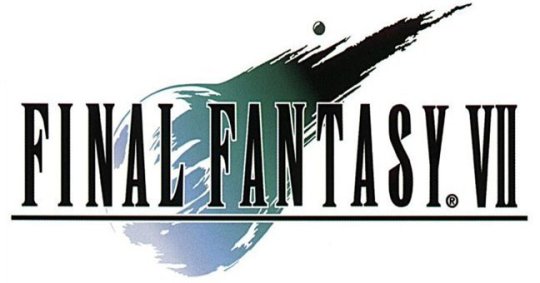
Year: 1997
Original Platform: PlayStation One
Also available on: PC, PlayStation Store
Version I Played: PlayStation One
Synopsis:
The Shinra Electric Power Company rules over the city of Midgar, and the eco-terrorists AVALANCHE stop at nothing to try and prevent the life essence of the planet from being used as energy. Barrett, leader of AVALANCHE, hires a mercenary named Cloud Strife for their bombing mission on a Shinra Mako Reactor. Cloud doesn’t care much for the greater cause and only wants his pay. But then, after a mission goes awry, he meets Aerith, a flower girl who is the descendant of the Ancients. He quickly finds himself wrapped up in the greater conflict against Shinra.
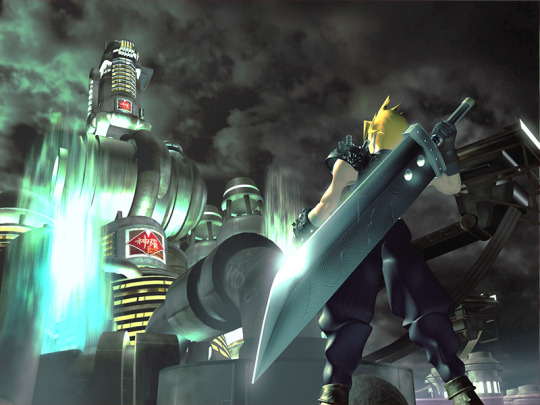
Gameplay:
Final Fanatasy VII utilizes magic spells via Materia – little orbs that come in a variety of colors pertaining to the natural elements. You can mix and match them on your weapons and equipment, which gives you access to different spells and stats. All your equipment varies with the number of slots for how many Materia orbs you can put in. Leveling up not only upgrades the character but the equipped Materia as well.
Final Fantasy VII also uses an ATB system but is known for introducing Limit Breaks – finishing moves that build up after the character gets hit over time. Final Fantasy VI had a prototype called Desperation Attack – but it was very rare as it only appeared when your character had 1/8 of their total HP, and there was a 1 in 6 chance of performing the Desperation Attack after selecting Attack. I actually had no idea that was a thing until long after I finished the game, and never experienced it when I played Final Fantasy VI.
Graphics:
Out of all the Final Fantasy games, I have to say that this one has not aged well. It has the worst graphics of the entire series. The battle and cinematic graphics are passable.
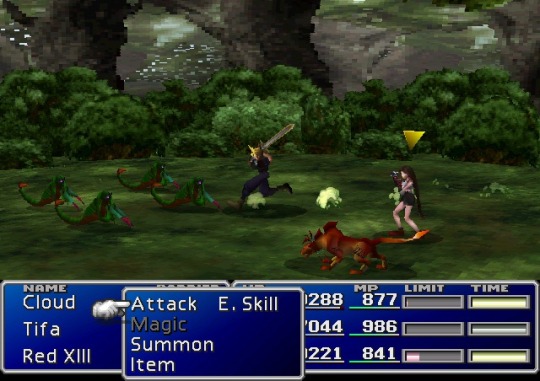

(Most of the graphics power seemed to be put in Tifa’s, uh, bosom.)

But the characters in towns, the overworld, and in-game cutscenes are incredibly blocky. PC versions are supposedly sharper, but the PlayStation One version makes it nigh impossible to see any facial expressions.

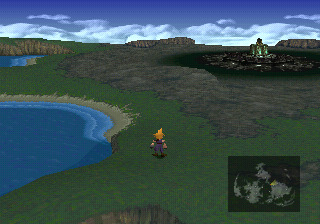
The graphics are definitely a product of its time. I always say that the beginning of 3D gaming was essentially like puberty – awkward and full of zits. It wasn’t yet at that stage where it could be aesthetically pleasing. We marveled about it when it was first released, yes, but then we cringed in retrospect.
The environment backdrops however are probably the strongest points, where they capture the industrial nature of Midgar, the reactors and other such buildings.
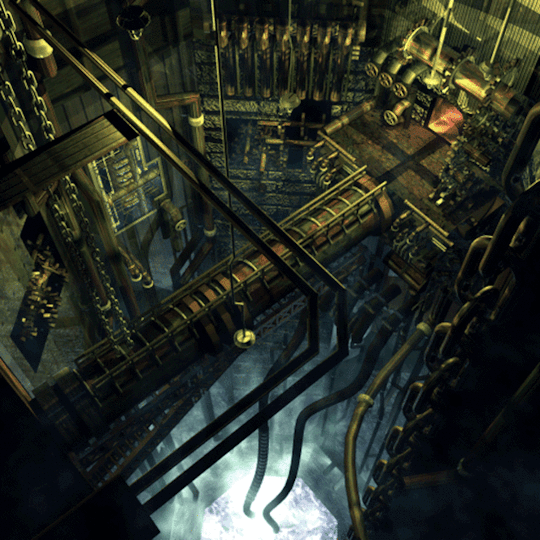
Story:
Final Fantasy VII became legendary the minute Square released it. Every aspect was memorable. Part of it could be due to the fact that it was the first Final Fantasy game to enter the 3D realm. Another part was Tetsuya Nomura’s character designs, which hit the cool meter to the point of sub-zero.
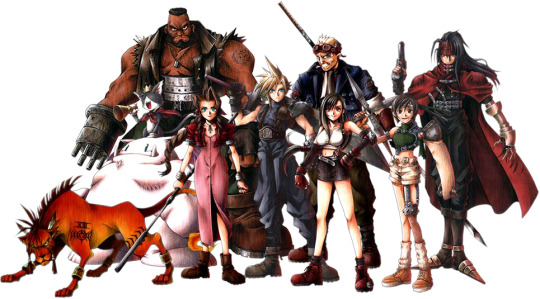
The cinematics blew our minds. The opening action scene with Cloud, Barrett, and the rest of AVALANCHE attacking Shinra’s mako reactor is the most memorable opening to a Final Fantasy game. Period. Final Fantasy games really do know how to start at the right spot, no matter how good or bad the overall game is. The opening is always the best part.
Then there was the motorcycle chase. Cid’s airship. The gun fights. Battles with Sephiroth. The extra stuff to find, like summons and extra bosses. So much was jam-packed into the game.
But the story was the primary factor in making VII famous. It’s definitely one of the better ones. Man, the story became so famous that even gamers who haven’t touched a Final Fantasy game knew the major spoilers. It is the equivalent to knowing Darth Vader’s line, “I am your father” without having actually watched Star Wars.
Aerith (Aeris in the English releases) Gainsborough – the innocent flower girl who holds the secrets of the Ancients – develops a romance with Cloud and fucking dies at the end of Disc 1 by the main villain – Sephiroth. The scene shocked everyone and practically made headlines. Everybody has seen the horrible image in one way or another.

It seems to me that since Final Fantasy V, the stories have gotten more and more used to main character deaths, ultimately transforming into a heavy-hitting TV series rather than simply a video game series. In other words – it matured. Looking back, Final Fantasy IV appears to be child’s play and a prototype of later dramatic storylines with fully realized worlds.
Final Fantasy VII was also the first Final Fantasy game to create a world much like ours – one with cars and trains and airplanes and machine guns and even cellphones. The main city of Midgar reflects industrialization at its worst, with miles of slums and claustrophobic cities. Shinra Electric Power Company is a reflection of capitalism at its worst - a single entity in charge of so much that it’s pretty much the government. For the first time in a Final Fantasy game, you play as characters who dance between the morally ambiguous line of terrorism and activism. Funny enough, the theme of neglecting the planet resonates with us now more than ever. This game ended up being rather prophetic about the uncontrollable growth of corporations.
While the story is memorable with many intriguing elements, the plot itself is a tangled web. In my opinion, they really hashed in so many things that it’s easy to forget crucial details. It’s not straightforward, but at the same time everything does connect by the end. While Shinra is the driving force as a whole as the villain, Sephiroth takes over, then you learn about his backstory and then with the evil scientist Hojo and the extra-terrestrial Jenova and then “Weapon” and then the planet’s history and this and that and the other thing.
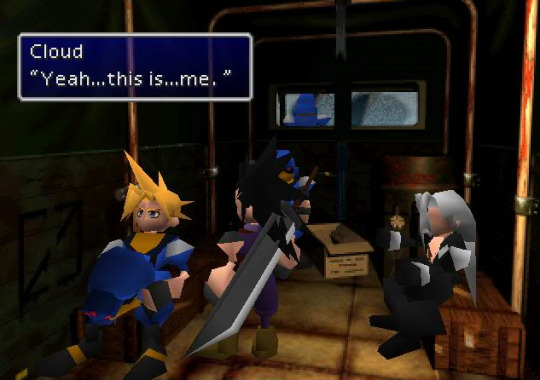
If I were to put Final Fantasy VI and Final Fantasy VII together and contrast them, as many gamers do, I would find that Final Fantasy VII is the summer blockbuster and Final Fantasy VI is the Oscar winner. Final Fantasy VII started introducing the sappy romance subplot to the series. A love triangle forms among Aerith, Cloud, and Cloud’s childhood friend Tifa. While there’s nothing inherently wrong with having a love triangle, the writing is like watching middle schoolers trying to express their feelings. Final Fantasy VI and Final Fantasy IV treated any romance with dignity and realism.
But maybe I’m being a bit harsh. After all, Cloud Strife did go through some suffering as an adolescent. His backstory clearly drives his antisocial behavior, so that becomes a good arc.
The goofiest but memorable part of the story deals with Don Corneo and Wall Market and running around store to store doing tasks in order to free Tifa from Don Corneo. It ends with Cloud needing to cross-dress as a woman to get inside Don’s mansion. Because, you know, it’s not like Cloud can just break in with his sword and Aerith’s magic or anything like that. But whatever. It’s anime.
The recent Final Fantasy VII Remake for the PS4 seems to streamline the story, and actually enhances the emotions they were trying to deliver in the original. I will be talking about the remake in a separate post altogether since I’m almost done with it at the time of this writing. But there’s a lot that I want to say about comparing and contrasting the remake and the original.
The latter half of the plot takes a couple weird turns. At one point, Cloud became catatonic and confined to a wheelchair.
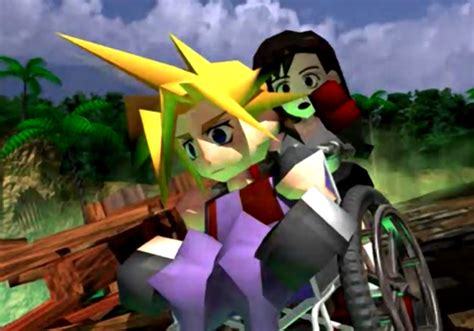
That part of the game became the sluggish part for me. Sephiroth also tries to confuse Cloud, which confused me. Cloud apparently suffers from some alternate subconscious mumbo-jumbo and like. . .ungh. I get an aneurysm thinking about it sometimes.
Complicated plotlines like Final Fantasy VII start showing up from here on out in the Final Fantasy series. The trend of bishonen characters also begin here, bishonen being the Japanese term for “beautiful boy.” Cloud and Sephiroth have that look. The series starts hashing in sappier romances and much more of an anime feel.
Final Fantasy VII ultimately marked the start of a new era for the series – introducing both cool and overused tropes.
Music:
Hands down the best Final Fantasy soundtrack of all.
The entire soundtrack of this game is memorable. The opening tune, with its light twinkle when the stars show up, is enough to make any gamer know exactly what that’s from.
With a story set in a more modern world, we have music that is more modern. After Final Fantasy VI had a more serious and operatic score, Uematsu displayed his love of progressive rock here. The motorcycle chase incorporates a lot of synth, which was fitting for zipping through the streets of Midgar. However, Final Fantasy VII is the first Final Fantasy game without that familiar starting bassline for the battle them. The battle theme is instantly recognizable but also radically different from its predecessors. It’s dramatic and displays danger.
Meanwhile, the boss theme is one of the best boss themes in the series, or any video game really. It’s an electrifying progressive rock piece, and it’s my personal favorite boss theme.
youtube
The more instrumental pieces are somber, given the dreary atmosphere of the planet. The world map music is very different from its predecessors. It’s romantic one moment, soaring the next, and then dips into foreboding terror. I guess that sums up the story of Final Fantasy VII.
And we cannot leave out One-Winged Angel, which I will talk about below.
Notable Theme:
Without a doubt, One-Winged Angel – played during the terrifying final battle against Sephiroth – is the most memorable piece of music in Final Fantasy VII.
youtube
It may very well be the most popular song of the entire series. Nobuo Uematsu was inspired by Stravinsky’s Rite of Spring. It’s a whopping 30 something minute classical piece. If you look it up on YouTube and browse through it, you can definitely note the similarities. However, Uematsu didn’t want some boring classical introduction to the piece. He wanted to add the destructive impact of rock. The theme has a very distinct stamping-your-foot-down quality to it.
I had noticed a certain piece-by-piece feel of the song and that’s exactly how Uematsu composed it. This is the only song that Uematsu has composed where he created several tunes in his head and then rearranged them to make a single comprehensive song.
If you want to get technical, One-Winged Angel is the first Final Fantasy song with lyrics. The chorus sings in Latin about Sephiroth’s burning anger, with some lyrics actually taken from the medieval poem Carmina Burana. It sounds fantastic when fully orchestrated.
In Advent Children, the animated sequel to Final Fantasy VII, the music is accompanied by hardcore metal. This new rendition really illustrates the destructive power of Sephiroth. Uematsu changed the lyrics for Advent Children. They are more original now. I specifically noticed the lyrics “Veni, veni, mi fili”, which translates to “Come, come, my son.” Sephiroth is inviting you so he can kill you.
youtube
Uematsu has stated that the original orchestration didn’t sit well with him. As I suspected, Advent Children’s hardcore metal version is the one he preferred, the one he would have composed had he the technology at the time of Final Fantasy VII.
Verdict:
Another must-play for any RPG fan, even if you think it’s overrated. It’s a must-play because of its popularity, in the same way that people are wide-eyed when you say you haven’t seen Star Wars or such-and-such other popular movie. It’s a whole lot of fun, especially in the scenes that involve other forms of gameplay, such as the motorcycle chase and even a battlefield strategy game in protecting Fort Condor.
Direct Sequel?
Yes – first there was the CGI movie Final Fantasy VII: Advent Children.
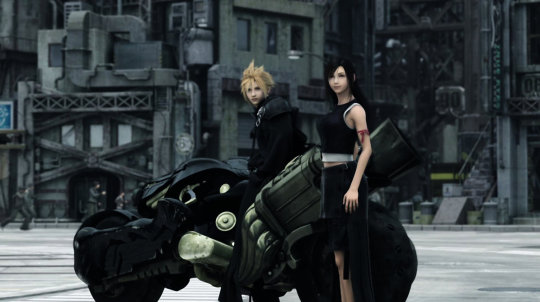
I actually watched Advent Children before playing Final Fantasy VII. I had already known most of what happened in the game and Advent Children became a monumental craze when it first came out. Everybody was talking about it. Watching the sequel before playing the game skewers your interpretation of things. My first impression of Cloud was that he was always whiny and angsty, and meanwhile Tifa kept nagging him to move on. I felt really bad for Cloud losing Aerith.
Then when I actually played Final Fantasy VII, I saw that Cloud starts as this badass mercenary. Tifa is spunky and clearly is the better choice (IMO) but Cloud is enamored by Aerith after only meeting her briefly. WHAT? Cloud. Bro. Make a move on Tifa, you nitwit. Tifa is AMAZING.
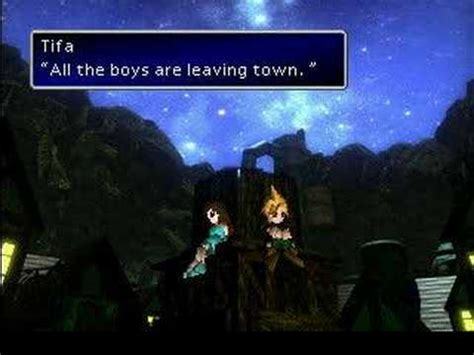
Square Enix then continued the story with Dirge of Cerberus – Final Fantasy VII. This video game sequel focuses on Vincent Valentine, a fan favorite of the original game.

Let me remind you about something – the original game revealed Shinra’s inner deep secret experiments, namely with Sephiroth and Jenova. Dirge of Cerberus introduces an even deeper research team within Shinra called Deepground. I don’t know about you, but it already sounds like the start of a terribly redundant string of sequels, like how the Jason Bourne movies keep revealing an even deeper level of conspiracy theories. Vincent’s mysterious background is now fully revealed. He is defined by – guess what? – another angsty lost lover story, this time with a woman named Lucrecia. Now, okay, look, maybe I’m just being a dick about these types of love stories. But when it keeps popping up within the same series in the same manner, I start asking if you have anything else to offer on your menu.
Lastly, there is the prequel for the PSP – Crisis Core: Final Fantasy VII. Of all the games in the Compilation of Final Fantasy VII, Crisis Core has received the most positive reception. If anything, play that after playing Final Fantasy VII before bothering with anything else.
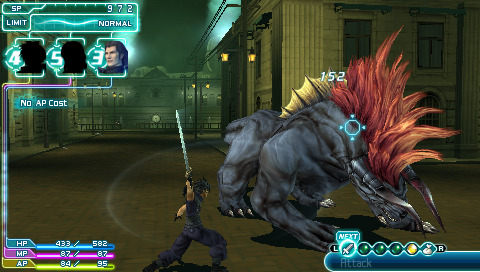
Oh, and of course there is the Final Fantasy VII Remake, which we thought wasn’t going to happen for the longest time but they finally released it in April 2020. More on that later after I finish it, and after I post my entire series of Final Fantasy reviews!
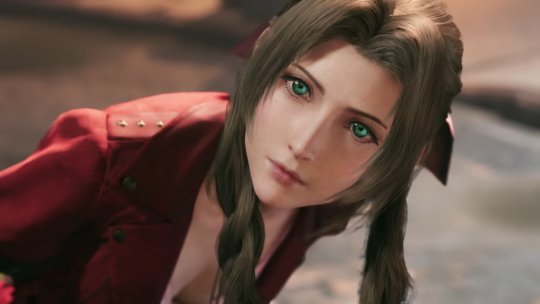
#final fantasy#final fantasy vii#final fantasy vii remake#aerith#tifa#tifa lockhart#cloud#cloud strife#cloud x tifa#cloud x aerith#aerith gainsborough#sephiroth#nobuo uematsu#square enix#fantasy rpg#video game rpg#rpg#midgar#video games#onvideogames
25 notes
·
View notes
Text
Final Fantasy XIII Review
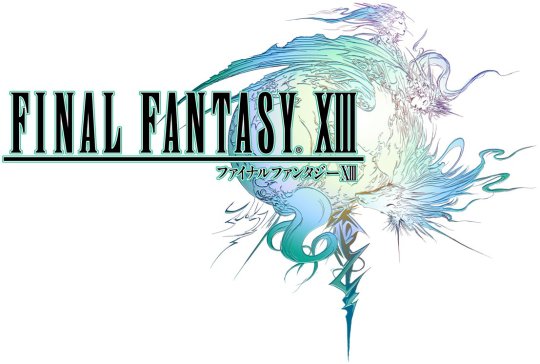
Year: 2009
Original Platform: PlayStation 3
Also available on: Xbox 360, PC, Android, iOS
Version I Played: PlayStation 3
Synopsis:
On the planet Cocoon, those who come into contact with anything from the planet Pulse are purged to that planet. Pulse is a feared planet full of monsters and strange creatures. Both planets are ruled by fal’Cie, mechanical godlike beings who sometimes brand humans as their servants for specific tasks, called a focus. Those who fulfill their focus are turned into crystals and obtain eternal life. Those who do not fulfill their focus turn into mindless monsters. Lightning is a former soldier whose sister, Serah, is branded by a fal’Cie and taken to be purged. Lightning sets off to rescue her.
Gameplay:
Going to say this now – the worst gameplay in the entire Final Fantasy series.
The battles are Active Time Battles but instead of you inputting individual commands, there are what’s called paradigms. Paradigms are somewhat like Job Classes from the old Final Fantasy games, except less fun and more automated. You can switch to a Medic paradigm in battle and every time you press “Auto-Battle” your character automatically performs a series of necessary cure and restore spells, based on what’s going on in the battle. The Sentinel paradigm specializes in keeping the enemy at bay. The Ravager paradigm uses magic. The Commando paradigm uses physical attacks. You get the picture.
As a result, the gameplay could be best described as:
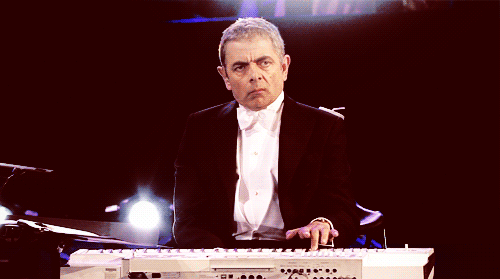
With occasional switching of paradigms whenever you see fit. You can set up a number of combinations across the characters. Two Commandos and one Sentinel. One Sentinel and one Ravager and One Commando, etc.
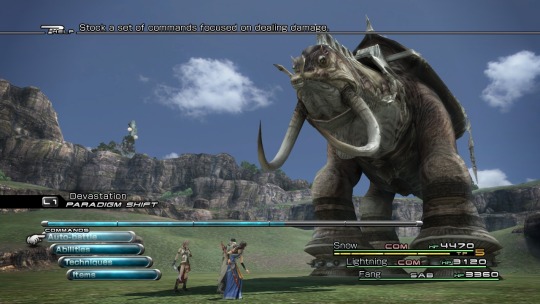

The party automatically heals after each battle – you can even press start during a battle and restart the battle.
I probably only used an item once or twice. I honestly don’t see why they bothered putting any items if you hardly ever use them.
You can upgrade your weapons with pieces and junk you find after battles. You find so many of them that you hardly ever think about what you’re upgrading so long as whatever you make upgrades your stats. Is this better? No? What about this? Okay, good. Moving on.
Like Final Fantasy X, the game is linear. Much more linear. You follow a long hallway for about 30 hours of the game before you can do sidequests. The sidequests involve completing other people’s focus. That’s about it. There are no towns, no inns, no villages. You are entirely on the road, constantly in battle (Okay, there’s like one time where Sazh and Vanille are in a casino or something but that’s about it).
I wrote a blog piece a while back about what exactly was wrong with Final Fantasy XIII, and it’s not that it’s linear. We play really great linear games all the time. It’s the automation – the feeling that you’re not really doing anything.
There isn’t an ounce of customization. Leveling up is similar to the Sphere Grid of Final Fantasy X. It’s called the Crystarium but it follows a strict path. You can’t actually stray anywhere or customize anything. If that’s the case, why bother making you open the menu to level up through the Crystarium? Why not just automatically do it? I guess they want to give you some ounce (more like a milligram) of control over the game.
Basically – you’re watching a long movie and occasionally get to move the people around. That’s how I see it.
Graphics:
PLAYSTATION 3 HD GRAPHICS HOMG DO YOU HAVEA BONER YET? LOOK AT THIS. FIRST FINAL FANTASY GAME IN GLORIOUS HD.

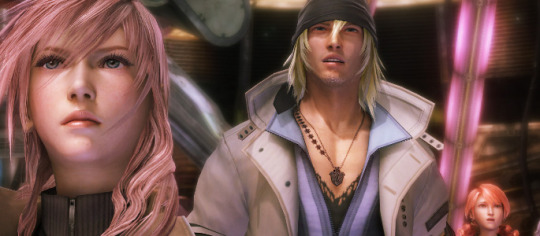
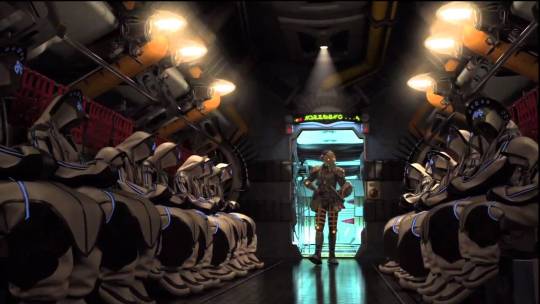
Everything is pretty in this game. Everything. There is nothing wrong with this at all.
Story:
The characters appear to reference those in Final Fantasy VII. Director Motomu Toriyama wanted Lightning to essentially be a female Cloud Strife. She’s a no-nonsense, athletic female lead. While Cloud and Squall were introspective and antisocial, Lightning is slightly different by actively ordering people around. She comes off as a dick to everyone, and that’s due to her ex-soldier background. Think of your stereotypical ex-cop/ex-CIA/ex-military action movie hero, like Liam Neeson (Bryan Mills in Taken) or Bruce Willis (John McClane in Die Hard). That’s basically Lightning.
Can we go on a short tangent for a moment to talk about how weird it is that Lightning was also used as a model for advertising in Japan?
Here she is driving a Nissan.

And wearing Louis Vitton.
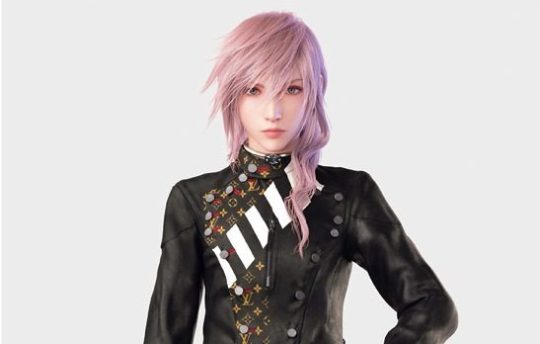
Cool? I guess? Unless you start to realize that Toriyama wanted to design his own personal waifu, and that he’s completely obsessed with her. That gets really weird. And sad? A little? Anyway.
Vanille has some reminiscent of Yuffie from Final Fantasy VII, although with more character via her inner monologues and narration. Fang is vaguely like Vincent Valentine. Sazh takes the place of Barrett as the token black dude, except instead of being aggressive he’s more like the comic relief and wants nothing to do with anything. Every time you control him, jazz music plays, because black people I guess. Hope doesn’t appear to be reminiscent of anyone – he’s just this boy who yells and complains a lot with Lightning. Snow meanwhile is a ripoff of Zell from Final Fantasy VIII, except somehow even more annoying.
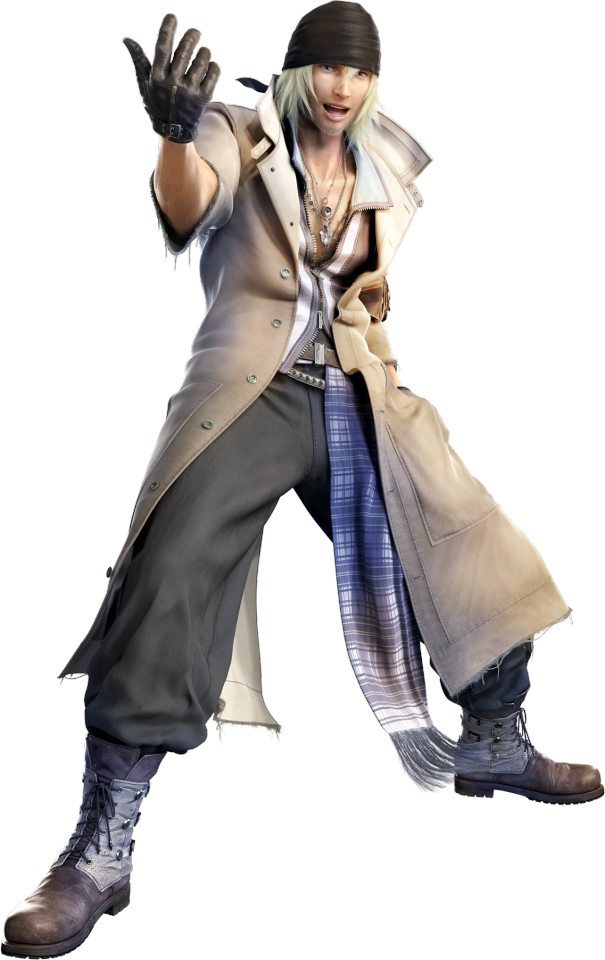
(Every time I see his picture I think about your typical dude bro at a frat.)
The story starts of a bit choppy as you follow almost each character separately, then they run into each other, then separate again, then join again. The first 30 hours or so gives flashbacks of 13 days prior- BECAUSE IT’S FINAL FANTASY XIII GET IT? Vanille actually narrates some events but it’s not exactly clear why or from when – but that’s a spoiler. Along the way, I got really confused because I didn’t know why some people were fighting each other when they were on the same side a moment ago. The concept of the “focus” is really weird and sometimes confusing. People with a focus simply have visions or a general idea of what they’re supposed to do, but they don’t actually know for sure unless they actively seek it. If the gods granted them a focus, wouldn’t it make more sense if the gods just told them what to do? Seemed to work in Final Fantasy XII.
In short, the narrative weaves around a lot. If you stop playing in the middle and pick up the game again months later, you’re bound to forget what’s going on. I know I did.
The characters didn’t annoy me as much as you would think they would on paper. They all have character development and that’s good. The only character that effectively got on my nerves was Snow. Snow is Serah’s fiancé, and Lightning hates him because of course you need some family drama. I don’t blame Lightning though. Snow shouts cheesy lines left and right, like “Heroes never die!”. He shouts Serah’s name the same way Christian Bale shouts Rachel’s name in the Christopher Nolan Batman films. Snow is quite possibly the most irritating character of all the Final Fantasy games. He will not shut the fuck up about what it means to be a hero.
The rest of the cast works well in that their motives and desires clash with each other. But I’m still sore about the wasted potential for a great character in Jihl Nabaat. Sazh wants his son Dejh back, who was taken to be purged by the sinister and extremely hot Jihl Nabaat.
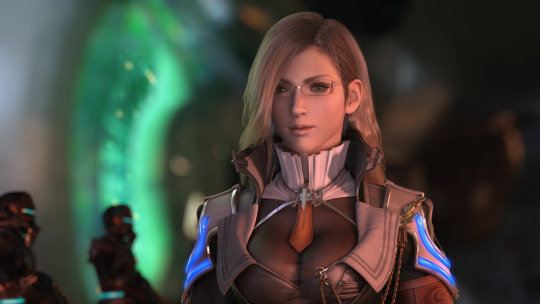
Goddaaayyyum. Seriously, look at her.
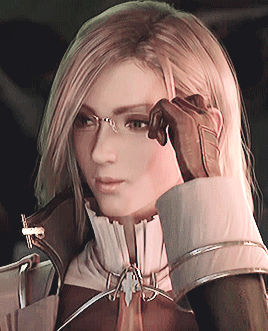
Too bad, because she’s only featured in a handful of scenes and then dies. Her death isn’t a major spoiler, at least one that I consider, because she hardly does anything except get in the way for a moment. You don’t even fight her. How lame is that?
Then you have this annoying bastard – Primarch Dysley.
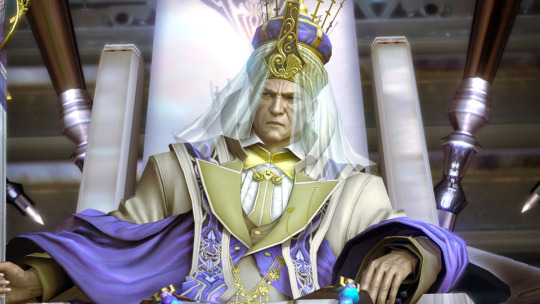
When I think of him, I think of Mitch McConnell.

Old. Disagreeable. Been in power for too long. Always in the way of progress.
Primarch Dysley happens to be as annoying as Seymour from Final Fantasy X, so expect to be overjoyed every time you run into him.
Overall, the story isn’t as bad as you’d think. You just have to pay close attention. The gameplay is far worse than the story. I could easily slip into a coma while playing this game and still make it pretty far.
Music:
Final Fantasy XII saw the departure of Nobuo Uematsu (well with the exception of the pop song “Kiss Me Goodbye”). Final Fantasy XIII continues to head into the unknown without the beloved longtime composer. This game’s score is composed entirely by Masashi Hamauzu, who if you haven’t been paying attention, already partly worked on Final Fantasy X. I immediately saw how “Saber’s Edge”, the boss theme, is similar in nature to the boss theme of Final Fantasy X.
Final Fantasy XIII made the most radical changes to the score. There are no signature themes from the series. No “Prelude” theme, no “Main Theme”, no “Victory Fanfare” theme. Instead, we get a theme called “Fabula Nova Crystallis”. It plays frequently throughout the game, and almost acts as Serah and Snow’s love theme. In some portions of the game, some woman is singing along. Yes – this is the first time where you roam around a world in a Final Fantasy game with actual pop music playing in the background – “Sunleth Waterscape” to be exact. Final Fantasy XIII’s music gets pretty poppy.
youtube
Not saying it’s a bad idea.
Just.
You got pop music playing in the background now.
“Lightning’s Theme” is pretty sick. Her theme plays during the battles in a rendition called “Blinded by Light” – HA GET IT BECAUSE SHE’S LIGHTNING. SO CLEVER.
But Hamauzu was a good choice – the entire score holds up well and sounds like a movie score, with varying motifs running across. It can be a bit more subdued but that’s how contemporary instrumental music is nowadays, especially with film composers like Hans Zimmer.
Notable Theme:
“Blinded by Light”
Really epic, unique song. I always scat along to it as it plays.
youtube
Verdict:
Uff.
Look, if you just search on YouTube for all the cutscenes, there you go. That’s the game. And it’s entertaining to watch. But it has the worst gameplay that doesn’t feel like you’re even doing anything. No sense of customization or originality.
Direct Sequel?
Yes, two.
Final Fantasy XIII-2.
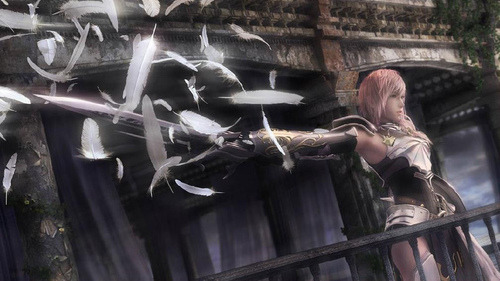
I started it around the time it first came out, but I’m still in the middle of playing it and I have no idea what’s going on in the story. NO idea. NONE at all. They use time travel but none of it makes sense. Apparently changing things in the future can change the past. I don’t know how. I only understand a vague semblance of a plot with the bad guy Caius. While it doesn’t tarnish the dignity of the original like Final Fantasy X-2 did, it’s still offbeat with its metal (yes, metal) music and utterly confounding story. It’s infamous for this metal rendition of the sweet and innocent Chocobo theme.
Then there’s the third game, Lightning Returns: Final Fantasy XIII
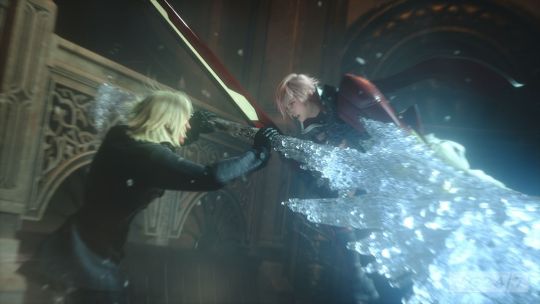
I plan on playing it after I finish Final Fantasy XIII-2, if I don’t already die from an aneurysm by then. It’s supposed to be better than Final Fantasy XIII-2 but lacking in graphics.
#final fantasy#final fantasy xiii#final fantasy xiii-2#lightning returns#lightning#final fantasy lightning#cloud strife#cloud clone#vanille#jihl nabaat#mitch mcconnell#video games#rpg#video game rpg#fantasy rpg#onvideogames
23 notes
·
View notes
Text
Final Fantasy VI Review
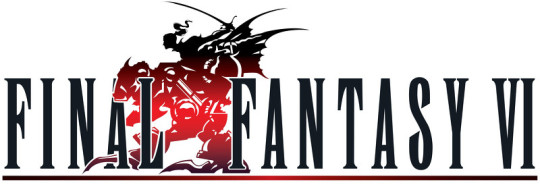
Year: 1994
Original Platform: Super Nintendo (originally released as Final Fantasy III in the West)
Also available on: Playstation One (Final Fantasy Anthology), Game Boy Advance, Android, iOS, Steam
Version I Played: Game Boy Advance
Synopsis:
Terra is a slave used by the Gestahl Empire because of her magic powers. The Gestahl Empire seeks to hunt down espers (summons) and harness their powers too, effectively killing them. Terra escapes their clutches and falls into the hands of the Returners – a small band of rebels hoping to return freedom to the world.
Gameplay:
Final Fantasy VI doesn’t exactly add anything super-new to the gameplay unlike its predecessors. That doesn’t mean there’s anything wrong or boring with it. It has an ATB system and each character, like in Final Fantasy IV, specialize in certain jobs. Therefore, each character has a special unique ability that no other character can perform.
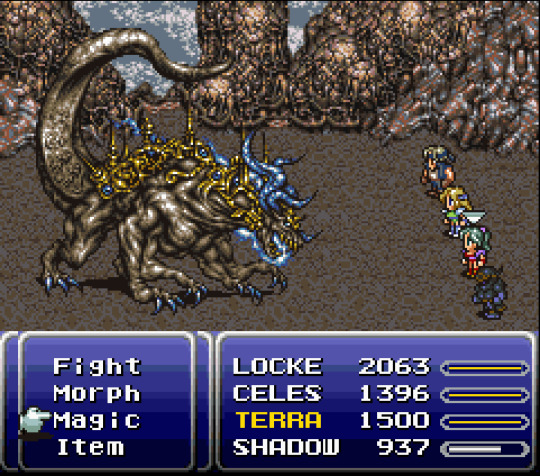
I find the style of the game unique for its time because you can easily split the game into two parts. There's a pivotal point in the story that changes everything. The first half is a typical story-driven RPG. The second half is actually more open world. With a huge cast of characters, you are not actually required to end the game with all of them. The second half of the game offers a unique style where you can take on the final boss with what you’ve got, or hunt down the rest of the cast members and then take on the final boss.
Graphics:
This is the SNES in its prime. Character sprites are much bigger, and the world looks so much more detailed and vibrant. Shadow looked weird though. Sometimes you had to squint to discern what his face actually looked like. Other than that, the game looks great! It’s notable for utilizing more graphics power from the SNES in some cutscenes, and also when you fly an airship.


The PlayStation One version again has a FMV sequence that hasn’t aged well at all. Okay, maybe it’s a tad bit better, but that’s not saying much.
Story:
One of the biggest debates in recent Final Fantasy fandom is asking whether Final Fantasy VI or Final Fantasy VII is better. While I won’t get into Final Fantasy VII much now, it was always the most popular game in the series. It seems that in recent years, gamers have retroactively judged Final Fantasy VI as the best Final Fantasy game of all time.
I wish I had appreciated more when I was a kid. When I first played it then, I actually despised it. I was much more critical about stories back then. For whatever reason, I didn't think the world building was coherent. I also wasn’t used to Final Fantasy games by then.
I finished Final Fantasy VI about four years ago, and that time I was taken by it. I became enlightened and completely changed my opinion of it from sour to sweet. I wish I could erase my memory on playing it only so that I could experience it for the first time and appreciate it for the first time. I had already known most about what happened in the story, so I really wish I could experience the shock and awe of it brand new. Final Fantasy VI does things with its story that no other Final Fantasy game has done. It has drama, it has brevity, it has an amazing cast of heroes and villains. To date, it has the most playable characters in a Final Fantasy game.
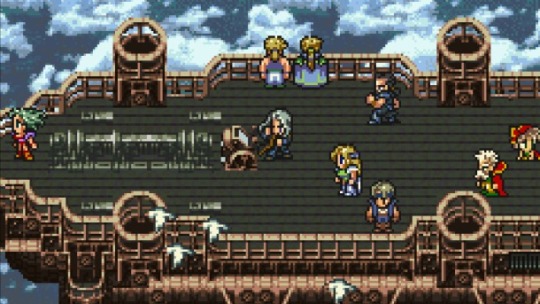
The plot even incorporates a little opera that you sit through.

At first glance, Final Fantasy VI seems derivative. There is once again an evil empire seeking to control the world, and there is once again a rebellion. People often make the parallel to Star Wars, much like Final Fantasy II. The name “Returners” doesn’t quite stick with me personally as the name of an epic rebellion. Final Fantasy VI also created the recurring characters Biggs and Wedge, a further nod to Star Wars.
But you have to look past the simple setup of a ragtag rebellion fighting an evil empire. First of all, the steampunk setting is one of the most original in a Final Fantasy game to date, and hasn’t really been revisited. The world dabbles in late 19th century architecture, with fine arts and opera. The empire is only beginning to realize the ancient power of magic, and combines it with technology to make “Magitek”, starting a sort of “industrial revolution”. The opening scene to this game is one of the most memorable. Terra, under the empire’s mind control device, in her magitek armor with Biggs and Wedge, trudging through the snow as the opening credits roll by, comes off as a real live-action movie.
While the official creators say that there isn’t a main character, I still say it’s Terra. If not, she’s at least the most important. She propels the plot forward. She’s one of those rare great female protagonists in a video game RPG. She’s more than just “a strong female character”. She has depth as she tries to find her place in the world, and other characters, such as the thief Locke, try to help her.
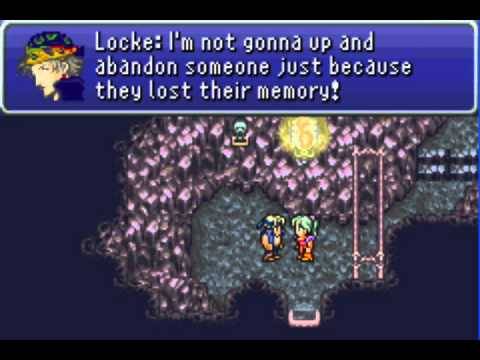
Also, just like Final Fantasy V, Final Fantasy VI has its own villainous goofball - Ultros.

He’s not quite as charming as Gilgamesh, but he acts in the same manner regardless.
Each character has their own story – no matter how small or big. They’ve all lost loved ones, or suffered hardships, and the central theme about the entire game is really about grief and dealing with it even in the face of nihilism.
Nihilism comes in the form of Kefka - Emperor Gestahl's court mage. Kefka did the whole nihilistic evil clown thing before Heath Ledger's Joker in The Dark Knight. Kefka retroactively rose to popularity, rivaling longtime favorite villain Sepiroth from Final Fantasy VII as the best Final Fantasy villain.

Final Fantasy VI deals with heavy topics. I was shocked that it even dared to show a scene of attempted suicide. Things get dark. Really dark. But Final Fantasy VI deals the darkness with such elegance. I admire its ability to treat such heavy plots for basically children.
The ending to this game is probably the most epic out of any Final Fantasy game. I can gush with details but this is meant to be a spoiler - free review. I just have to say – E P I C. But the most admirable thing I just have to say is that it treats Terra’s journey with the utmost respect and tact. It doesn’t try to define her by having some hokey romantic subplot.
Music:
Another legendary score. Given the tone and atmosphere of the story, the score reflects something darker. Right away, the opening titles before you begin is accompanied by foreboding music. With the exception of battle themes, the story demanded that Uematsu put away most of his drumming and rock undertones for a more conventional, instrumental score with pathos. It sounds most like the score to an actual fantasy movie, very operatic and Wagner-like.
Shadow’s theme sounds inspired by typical Western movie fare, being that he is a drifter. In fact, Final Fantasy VI’s score is diverse in tones with its character themes, which is obvious once you think about where all the characters come from. Cyan’s theme has Asian influences. The theme for the Veldt, a stretch of wilderness, has a jungle beat. Then of course there’s the opera music. Many Final Fantasy concerts, such as Distant Worlds, play the opera about the fictional characters Draco and Maria. Kekfa, the villain, has a jovial but sinister theme scattered throughout. Terra’s theme is practically the main theme of the game, and it too is referenced throughout.
The end credits song is a whopping 21 minutes and 36 seconds. It goes through every single character’s theme and more. The entire soundtrack is 3 hours long. I don’t think any other game at the time had a soundtrack that long.
Notable Theme:
“Dancing Mad”
To me, Dancing Mad is Nobuo Uematsu's magnum opus. It is a sprawling 8-minute epic for the final battle.
youtube
Verdict:
A must-play. Any RPG fan will love this game. Any RPG fan SHOULD play this game. There’s nothing obnoxious or vainglorious here. Every subsequent Final Fantasy game tried to live up to its drama and scope, but with all of them falling short ever so slightly.
Direct Sequel?
No. Thank God.
#final fantasy#final fantasy vi#final fantasy kefka#kefka#kefka palazzo#square enix#fantasy rpg#rpg#video games#video game rpg#onvideogames#terra branford#terra
33 notes
·
View notes
Text
Final Fantasy V Review
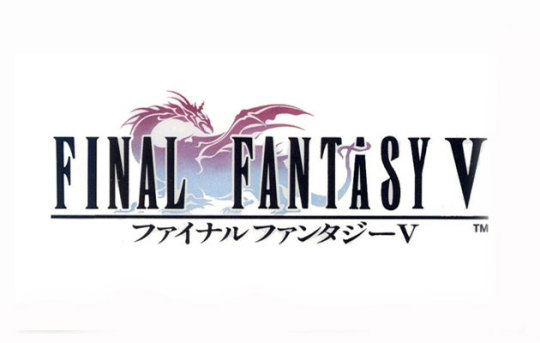
Year: 1992
Original Platform: Super Nintendo
Also available on: PlayStation One (Final Fantasy Anthology), Game Boy Advance, Steam (updated graphics)
Version I Played: Game Boy Advance
Synopsis:
Bartz is a drifter, riding across the world with his chocobo – Boko. One day, the wind seems to fall. Lenna’s father, the king of Tycoon, goes off to make sure the Wind Crystal is all right, but doesn’t return. Meanwhile, a meteorite falls. Lenna and Bartz check it out separately, where they find each other and a man named Galuf with amnesia. Together they figure out that the world is falling apart – the crystals that drive wind, fire, earth and water are dying out. They stumble upon a pirate hideout led by Faris, and together they seek to restore the world and uncover the mysterious forces behind the destruction of the crystals.
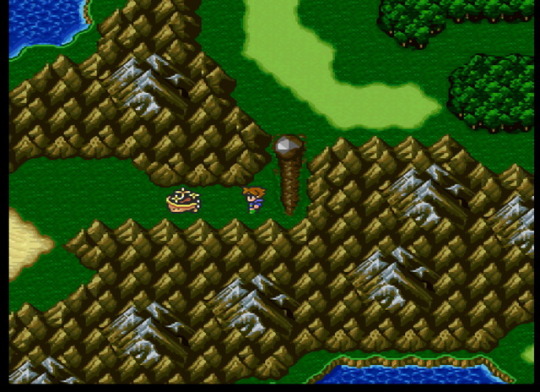
Background:
Once again, this Final Fantasy game was originally unreleased outside of Japan. Unlike II and III, the developers thought that the game was a different tone than the others and the vast job system would be too complicated for Western audiences. The West didn’t experience Final Fantasy V until 1999 with Playstation One’s Final Fantasy Anthology; a compilation of both V and VI. One notable change from the Japanese version is the name Bartz. The original name for Bartz in the Japanese release was translated as Butz, but because Americans are immature and laugh at such a name, they changed it in the localization to Bartz.
Gameplay:
Holy capitalism, Batman – so many jobs!
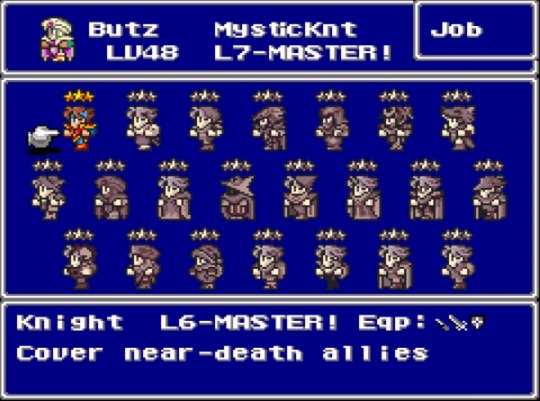
Not only that, but each job has abilities that you can mix and match! Every time you level up a job, you earn a new ability for that job. You can switch those abilities across jobs.
The possibilities are seemingly endless!
The gameplay is the most fun I had with customization in a while in any video game RPG. The best part is that the Job System is so rewarding by the time you reach the third act of the game. It gives you such a variety that it allows you to approach battles from many different angles. There’s no one way to be a badass and deal destructive damage.
It’s so much fun that once a year, Final Fantasy V gamers join in “Final Fantasy Five Four Job Fiesta”. It’s a challenge where you are randomly assigned four jobs in the game and have to finish the game ONLY with those four jobs. I’ve joined in the challenge myself and it’s a great way to come together with Final Fantasy players.
I had fun unlocking the legendary weapons and hunting down the most powerful summons - this time naturally without looking anything up. I find it interesting to say that I had legit fun hunting down all the extras. Sometimes in other Final Fantasy games I get weary over hunting for some extra, higher powered spells and summons. I sometimes even wonder if I should bother going after them. The vast Job System in Final Fantasy V keeps you occupied for the entire game and more. I finished the game and there are still some jobs that I haven't even touched. Luckily, the Game Boy Advance version adds some extra dungeons after you complete the game.
Graphics:
The sprites in this game look a bit rough around the edges. They also come off as too small in my opinion. The same is said of the Game Boy Advance version. Regardless, it now looks like an actual SNES game. Unlike Final Fantasy IV, it has more color, structure, and doesn’t look faded.

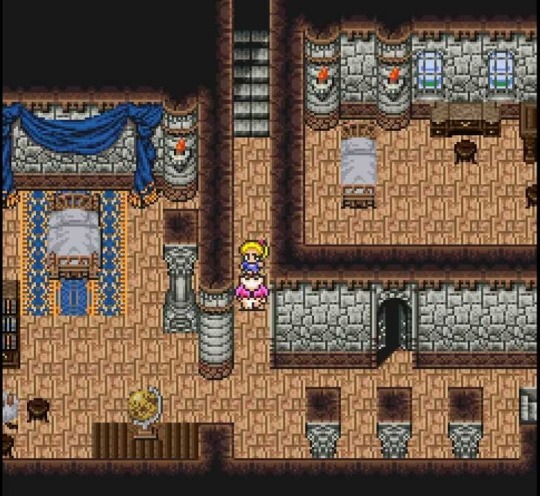
Something irked me though about the sounds. I never have anything bad to say about the sound effects, but for some reason, in this game, the battle sound effects were meek. Even when someone had a sword, the attack sounded puny.
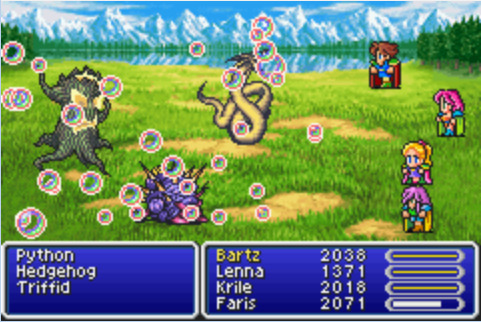
The PlayStation One version has an FMV sequence that look awkward and ugly as fuck, just like the FMV sequence for the PlayStation One version of Final Fantasy IV. As much as I love Yoshitaka Amano, trying to transplant his style into 3D is not a good idea.
Story:
The story transcends that of Final Fantasy IV. Where Final Fantasy IV can feel weak or simple at times, Final Fantasy V delivers a strong, emotionally charged storyline.
It starts simple. Once again, the world is in danger because the crystals are in danger – but this time because humans are misusing their power and breaking them. So this is a rare Final Fantasy game without any evil empires or rebellions.
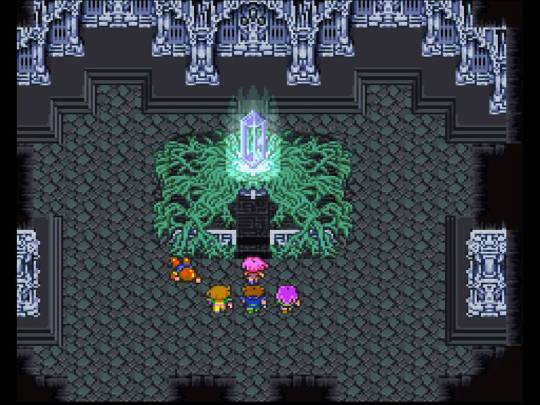
Out of all the Final Fantasy games, I had heard the least about what happens in V. Heck – I knew more about II before going into it, mostly because of what people said about the Star Wars parallels. It’s been a long time since I went into a Final Fantasy game completely blind. I kept it that way and was very pleasantly surprised.
I can see what the developers meant by a “change in tone.” Final Fantasy V is probably the funniest of them all. It’s not campy – just humorous. Galuf loves to share puns. Bartz can be a klutz. The characters bicker a lot during their journey. One part actually made me genuinely laugh out loud when you are in a certain underground place searching for clues:
Despite the lighter tone, each character has a pretty sensitive, delicate backstory. I cared for Bartz’s personal history with his parents. I worried about whether Lenna’s father would die or not. I wondered what Galuf forgot and who Faris really was. There are dashes of tropes here but none of them stand out too much. You have to remember that tropes themselves are not inherently bad – what matters is how you utilize them. There’s no hokey romantic subplot thrown in either, which is extremely rare in a JRPG.
It was so rewarding to go into it blind because there was even a shocking death. I thought maybe they would be all right in the end through some Disney cop out.
No. That person is dead. Dead as a door nail. Never coming back. I also enjoyed the bit where they tried to revive said dead person with spells and phoenix downs. They finally imply that there can be a point where someone can go beyond and it’s too late to bring them back.
The henchman Gilgamesh is very memorable and lovable, probably the most memorable character of the entire game. He serves as great comic relief while not being at all annoying. I kept hoping he would show up.

My only real complaint, if I’m ever forced to say anything bad, is that Boko wasn’t really an asset in the story, at least not as much as I assumed he would be.
The story is unfortunately very overlooked. I can understand that maybe at the time American and other Western gamers may have found the third act strange – especially after learning about the villain Exdeath’s true nature. Compared to the other Final Fantasy backstories, it’s a little out there, and something tells me it relates to Japanese mythology. But today? You’d be sorry to miss out on it.
Music:
Final Fantasy V’s main theme is somewhat reminiscent of Final Fantasy IV’s main theme. They have this melodic soaring feel with a continuous beat. “The Four Warriors of Dawn” in Final Fantasy V is reminiscent of “Red Wings” in IV. Meanwhile, the biggest and most interesting display is “Battle with Gilgamesh”. (sometimes titled “Clash/Battle on the Big Bridge”). The piece opens up with some intense drumming. While the later orchestrations and adaptations of “Battle with Gilgamesh” are pretty good, nothing seems to capture the tempo and umph of the original.
“Dear Friends” is probably the most endearing tune in the soundtrack. It’s played at the end and gives a really bittersweet feel. The Distant Worlds concert version is extremely bittersweet. It has a sweet, gentle guitar, and it reminds me of how Uematsu said one of his inspirations was Simon and Garfunkel. “Dear Friends” definitely has that folk tune.
Exdeath’s theme song gives a heavy rock vibe. That heavy rock vibe was last heard in the opening segment of the final boss fight in Final Fantasy IV. The rest of the score has a lot of drumming incorporated, partially due to the fact that pirates are involved in most of the plot. Ultimately, this Final Fantasy score broke out all of Uematsu’s classic and hard rock inspirations – and it’s fucking awesome.
Notable Theme:
“Battle with Gilgamesh”
I have replayed this song over a thousand times by now.
youtube
Verdict:
Definite must-play. It’s the most underrated Final Fantasy game. The Kob System can be overwhelming, especially if you have never played a Final Fantasy game before. I wouldn’t suggest playing this for beginners – more after you get your hands wet.
Direct Sequel?
Yes. And No.
While not a video game, Final Fantasy V did receive an anime sequel titled Final Fantasy: Legend of the Crystals. It’s technically the first sequel to a Final Fantasy game. The anime is set 200 years in the future, with the heroes of the original game having become legend. Critical reception of the miniseries was mixed.
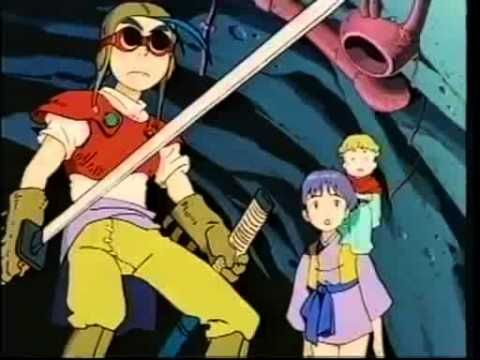
#final fantasy#final fantasy v#square enix#super nintendo#nintendo#underrated video games#video games#onvideogames#fantasy#rpg#jrpg#rpg game#video game rpg#chocobo#four job fiesta#final fantasy five four job fiesta
21 notes
·
View notes
Text
Final Fantasy XV Review
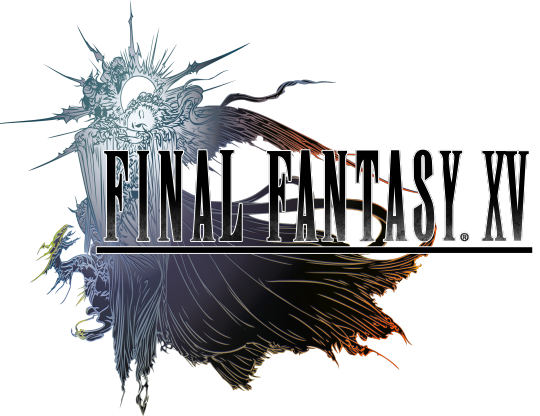
Year: 2016
Original Platform: PlayStation 4
Also available on: PC (Steam), XBox One
Version I Played: PlayStation 4
Here we go. The final Final Fantasy review of the main single-player games. I just want to say, first off, we’ve been waiting for this game since 2006. It took them ten damn years to finally release this game. I clearly remember the teaser trailer they released when it was called Final Fantasy XIII Versus, and my next-door neighbor and I were so hyped for this game when we were freaking teenagers. After years of delays, Square Enix revamped it into Final Fantasy XV.
Did it live up to the wait? Well, read and find out.
Synopsis:
Noctis Lucis Caelum is the heir to the throne of the kingdom of Lucis. On his birthday, he sets off with his three best friends and bodyguards (Ignis, Prompto, Gladio) to marry his betrothed, Lunafreya. The marriage is supposed to be a political one, though Noct and Lunafreya had grown up together and become fond of each other. But peace turns to war as the empire of Niflheim betrays Insomnia and invades. Noct, now on the run, has to reclaim his right to the throne by collecting the necessary family heirlooms which will banish the darkness.
Gameplay:
Open-world Final Fantasy.
That is the big selling point for this game.
A MASSIVE step up from Final Fantasy XIII’s gameplay, Final Fantasy XV has you roaming around and attacking enemies on the field in real time. The battle system returns to something slightly more conventional by having you cast spells and use items. It seems like this is what Square really intended to do after Final Fantasy XII. Looking back, Final Fantasy XIII feels like some prototype before Final Fantasy XII, so it really becomes apparent that Final Fantasy XIII’s gameplay comes off as a huge mistake.
This game’s major’s strength comes from the player engaging with a massive world. You camp. You take on hunts. You take on a bajillion sidequests. You run across the world. You drive across the world. You can ride a chocobo across the world.

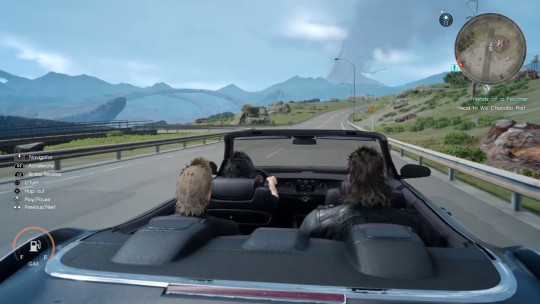

However, the dip in the gameplay comes from how easily accessible these sidequests are. The map tells you exactly where you go 24/7. I started to have an existential crisis around my 50th sidequest in a row. Why am I doing this? What’s the point? I go here to kill a thing, or go there to help someone by giving a potion or taking a picture. You start to realize that a good bulk of sidequests are either hunting daemons or fetching an item. You start to deconstruct the meaning of playing a video game as you think to yourself, “Why do I play video games?” while also thinking “But wait, one more and then I swear I’m done.”.

I get it, not everyone has the time nowadays to figure out a huge game like this. I get it, video games are now marketed to everyone for ease. At the same time, I personally love a good challenge. I mean, I’m the guy who has Dark Souls as one of his favorite video games of all time, so my opinion on the matter might definitely be skewered compared to most. I generally want to feel like I actually figured something out by myself rather than following a tracker on the screen and walking from task to task and then saying, “Okay done. Next.”.
Too much of that and playing a video game starts to feel like a 9 to 5 job to me. This game is great to play during quarantine, but at one point I saw playing this game as feeling like an actual job. Wake up, eat breakfast, time to hunt some daemons.
This is the growing conflict some people have with story-driven games versus open-world games. I see the argument focused too much on words like “linear”, but in reality we should be talking about “automation”. If a video game is too automated, then did you really play a video game? Or did you watch a movie that allows you to control the camera angle? At first, the idea of driving around an open-world Final Fantasy game sounds amazing. Isn’t that what fans always dreamed of? In reality, you don’t really drive around at your leisure. Even when you have the car set to “manual”, you can’t speed up, drive off-road, or pull off a sick drift like in The Fast and the Furious. Your car still automatically stays on the road wherever you’re going. It’s not so much “manual” as it is “I can control where and when to stop and which road to take”. Riding chocobos at your leisure is much more fun, but becomes increasingly impractical as you can just fast-travel to necessary locations in your car.
The sights and sounds of the fictional world of Eos are enough to gloss over these shortcomings though. It IS still fun to roam around and fight monsters and save the day. My bottom line is, “You don’t think about just how mindless the tasks are unless you keep playing for many days straight.”. And I poured hours into this game day after day because of the 2020 pandemic quarantine.
Graphics:
Obviously the best thus far. However, in-game facial expressions on the NPCs are still quite stilted and awkward. This game made me realize that we’ve yet to jump a hurdle when it comes to in-game graphics. The game is so polished but there are still limitations when it comes to giving the characters natural movements, both in body and lips. So an NPC could be shouting “WOW THAT’S AMAZING!” but have a straight face jumping up and down, despite the fact that the character model is the most realistic we’ve created so far in a video game. I was looking back at in-game cutscenes of Crisis Core: Final Fantasy VII, and found it ironic that they can portray body movements so much better, but that’s the trade-off. Less graphics power to portray realistic bodies, but the graphics power can then be allocated to focus on natural movements. Nowadays, all the graphics power is focused on making things look good, but that hardly leaves room for making things move naturally.
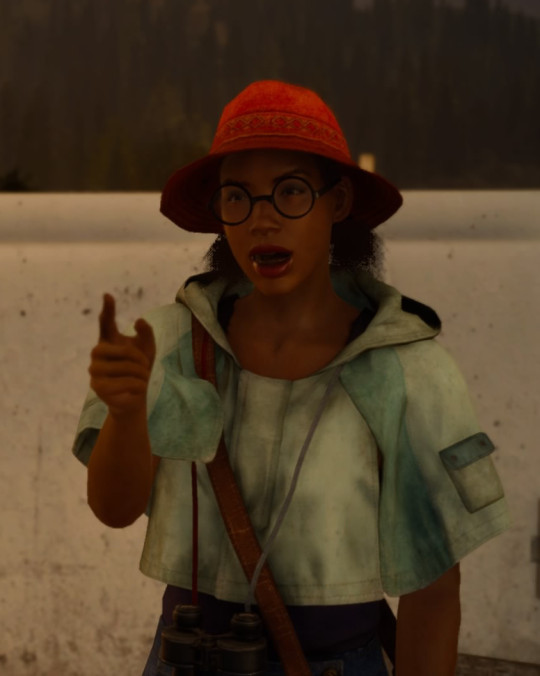
Story:
After the overly-complicated plotline of Final Fantasy XIII, Final Fantasy XV feels like a breath of fresh air. On the surface, it’s a straightforward tale of a boy seeking to become a king after his father is brutally murdered by enemy forces. The bromance between the young king and his bodyguards is endearing. Each character feels distinct and genuinely makes you laugh. The setup sounds like prime real estate for an emotionally charged storyline.
Unfortunately, it falls apart somewhere around the last quarter. What should have been a strong and straightforward story turned into a rushed, hasty mess by the final act.
The story started SO strong, they practically had it in the bag, but then it became apparent that many important elements were glossed over - especially when it came to the main villain. I realized that some things required me to read between the lines, or even were only explained in character dossiers in the archive section of the menu. Supposedly, the movie Kingsglaive: Final Fantasy XV explains more, but do you really expect me to have to watch a separate movie to understand the actual game? The final quarter of the story feels like someone was trying to finish NaNoWriMo, realized they were running out of time, and quickly jumped from scene to scene to reach that 50k word goal. The ten-year time-skip is a joke. The final chapter is sorely disappointing.
The ending was appropriate though, and even beautiful. However, the overall story didn’t have the necessary emotional weight to really make me feel anything. I thought to myself, “I feel like I should be tearing up but instead I feel nothing.”. Even Final Fantasy XII, which lacked a romance, had me swelling up at the end. Final Fantasy XV didn’t make me swell up until literally the last few seconds of the post-credits scene.
People complained about the advertising (Coleman, Cup Noodles) but that didn’t bother me.
What does bother me is the lack of variety in the main cast, and in numerous ways. There were so many interesting side characters that didn’t receive much screen time, or use at all in the story. The strong focus on only the four male leads made it a sausagefest. I was craving more out of Aranea Highwind and Iris Amicitia. They are important but don’t get any screen time at all in the final chapter, nor do we ever hear from them ever again after the time-skip. Aranea Highwind was such a cool character, but once again ends up being wasted potential.
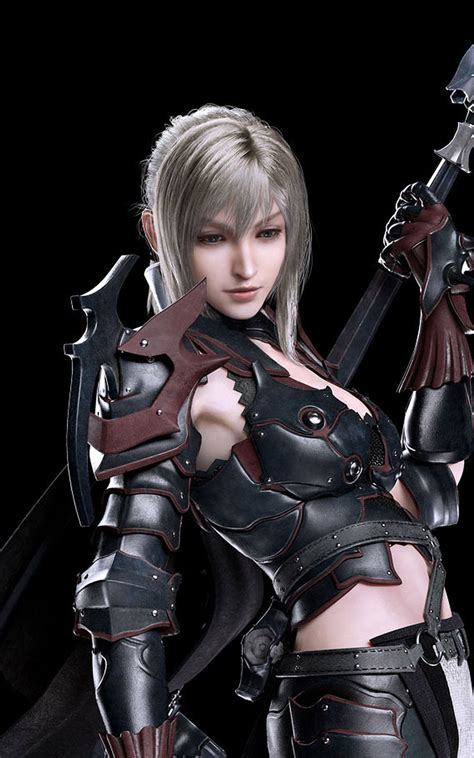
The main cast lacked distinctive styles. When I first saw the main cast, I had a hard time telling them apart. They looked like a k-pop band. Compare the main cast of Final Fantasy XV to literally any other Final Fantasy main cast and you can immediately spot the difference.
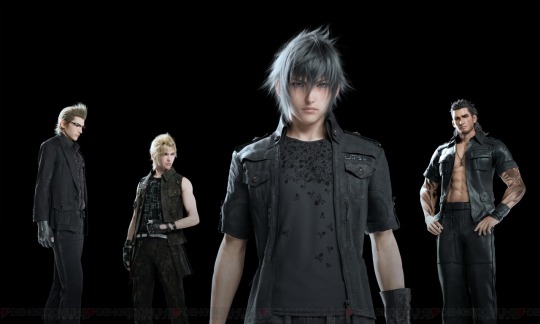
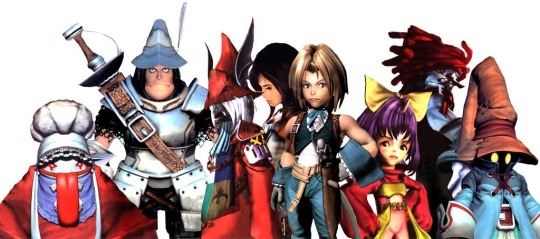

The four main leads do have distinct personalities, and I quite loved hearing their comments and banter. It felt realistic, but at times it became ridiculous. I rolled my eyes when Prompto would say things like, “Hashtag sorry not sorry.” That was a bit too on the nose, and came off as Square trying to pander to the current generation.
But what really rubbed me the wrong way is the incredible lack of non-white characters in the entire game. Lestallum feels so wrong to me as a Hispanic. Lestallum is supposed to be modeled after Havana, Cuba.
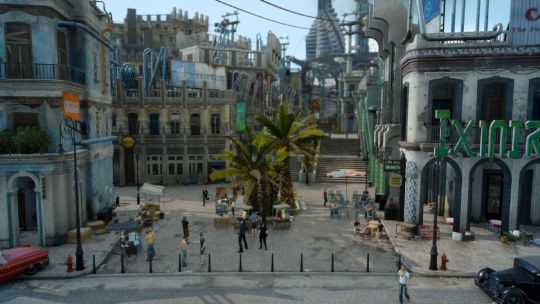
Its music, its buildings, its activities. It has a tropical climate, and yet every single denizen is pale white. Every. Single. One. I am not exaggerating. It feels so absolutely wrong walking around that city and not seeing anyone with the slightest shade of brown. This isn’t some uncalled-for SJW rant, it’s a simple fact. Tropical climates breed tanner skins. My brain naturally did a double-take when seeing the all-white population, saying, “Hmmm, something’s wrong here.”. For God’s sake, Final Fantasy XII, made over a decade earlier, did a better job at displaying the various nuances in skin tones, and that was on the PlayStation 2! Final Fantasy X, even older, seemed to properly portray tropical beach populations, inspired by the Philippines, with the character Wakka.
I noticed that they really took the time to incorporate elements from virtually every single Final Fantasy game. Aside from the crystals, the modern settings, and other obvious elements, four male leads are reminiscent of Final Fantasy III, the sinister chancellor hearkens back to Kefka from Final Fantasy VI, the enemy Yojimbo resembles Final Fantasy X’s version of Yojimbo, a certain boss battle reminded me of Cid Raines from Final Fantasy XIII.
Also, there’s Dino. Quite possibly the most annoying Final Fantasy NPC ever.
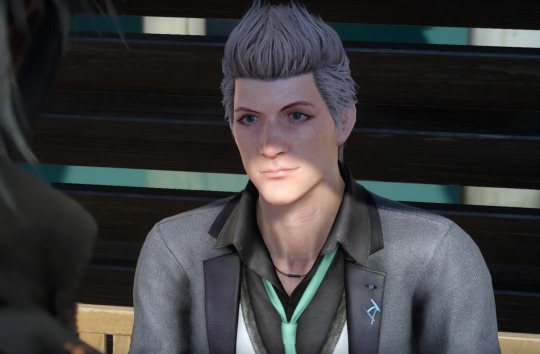
The overly obnoxious Italian stereotype made me want to punch his face, and also took me out of the experience of the fictional world. Every time you spoke with him he's all like "HEY HOW YOU DOIN WELCOME TO OLIVE GARDEN YOU TALKIN TO ME BADA BING BADA BOOM SPICY PIECE OF MEATBALL CAPISCE? AMIRITE??"
Square seemed to treat this game as a milestone in the series, alluding to everything the series ever did. It’s a shame that the story itself wasn’t quite up to snuff to be held in such regard.
Music:
The game’s major lyrical song is copyrighted, which is a first for a Final Fantasy game. It makes sense why they chose the song “Stand by Me”, both in literal and figurative terms of the story.
The score to this game is quite fantastic. The series has its first female composer, Yoko Shimomura. I have absolutely no complaints about the music. Nobuo Uematsu didn’t even pop into my head during the entire game. It’s the first time since Uematsu’s departure that I felt immersed in the score. The motifs are distinct and strong. The battle music is vibrant and an orchestral orgasm to listen to.
Notable Theme:
“Somnus”
youtube
The main theme of the game. It plays right away in the main menu. I love how it is incorporated into the rest of the score, and my brain kept wanting to hear it to its completion.
Direct Sequel?
Nope. However, there is downloadable content that fills in the gap of events within the game. Supposedly, Final Fantasy XV is loosely connected to Final Fantasy XIII and Final Fantasy Type-O, all sharing common themes and possibly set in the same universe. You can also watch the prequel movie, Kingsglaive: Final Fantasy XV.
Did it Live up to the Hype?
Eh.
Yes, and no.
It was cool to play around, but the rest is a flaccid attempt at being a notable entry in the series “for fans and first-timers”, as the words proudly display every time you load the game. It’s not the worst in the series, but certainly not the best. It’s somewhere in the mid-to-low tier.
#final fantasy#final fantasy xv#square enix#ps4#fantasy#fantasy rpg#rpg video game#rpg#video games#onvideogames#noctis#ignis scientia#prompto argentum#gladiolus amicitia#aranea highwind
15 notes
·
View notes
Text
Final Fantasy III Review

Year: 1990
Original Platform: Famicom
Also Available on: Nintendo DS, iOS (DS port), Android (iOS port), Ouya (Android port), Steam (Android port), PSP (iOS port)
Wii/3DS/Wii U Virtual Consoles and Nintendo Classic Edition releases are only in Japan.
Version I Played: DS
Synopsis:
Four orphans (originally only named by the player, DS remake gives them names) fall into a crevice after a sudden earthquake. There, a mysterious crystal warns them about the oncoming darkness that will engulf the world. The four orphans must band together to restore the balance between light and dark.
Gameplay:
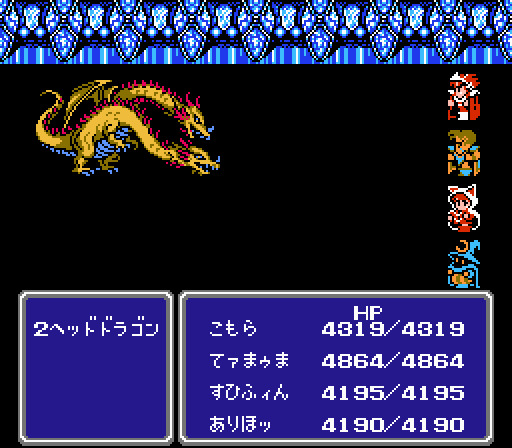
ARE YOU READY TO GET YOUR ASS BEAT?
YOUR BALLS ROCKED?
I’m warning you – this is the most difficult Final Fantasy game to date.
There are no ethers - only elixirs, which you should definitely reserve for the hardest battles. Also, phoenix downs cannot be found in stores - only in treasure chests and as dropped or stolen items from enemies.
The gameplay returns to that of the original Final Fantasy – turn-based combat and the Job System, only this time the Job System is greatly expanded. Vikings and Geomancers and Bards and Dragoons and the list goes on. Summons are introduced to the series via the Evoker job, which later gets upgraded to Summoner. The expanded Job System allowed for greater customization of your four characters than in the original Final Fantasy.

This game is notable for the Onion Knight. In the beginning of the original Famicom game, the default job is Onion Knight. If you continue playing as an Onion Knight, your stats remain relatively low. However, if you dare to play the entire game as an Onion Knight and reach level 99 – the Onion Knight suddenly turns into the most powerful job in the game.
The DS remake does things a little differently. Instead of the Onion Knight, you start out as a Freelancer – a new job that has a little bit of everything. However, the longer you use the Freelancer job, the weaker you become. This is a good incentive to have players naturally explore other jobs.
The unfortunate feature of the DS remake though is that the Onion Knight is ONLY available after performing sidequests via wireless with friends. This is impossible to do now since the wireless features for the original Nintendo DS (and also the Wii) have been discontinued. HOWEVER. Playing the DS remake through Steam allows you to unlock the Onion Knight by completing at least 25% of your bestiary. You will then receive a message via the Mognet to start the sidequest.
Final Fantasy III is notorious for its high difficulty. The trick mostly lies in constantly switching between jobs and finding the right balance for the right moment. However, changing jobs requires you to level up that job. This means grinding – lots and lots of grinding. Insane amounts of grinding. This is Final Fantasy: Grind City.
In retrospect, Final Fantasy II was hard as well, yes, but more in a stupid way. Leveling up there was annoying but people could find tricks around it like finding weaker enemies and purposely hitting yourself and healing yourself to raise your HP or defense stats.
Final Fantasy III is difficult but it hurt so good. This game turned me into a masochist. There's two types of video game rage - the good and the bad kind. The bad kind is usually because the game's mechanics are irritating or virtually unplayable. The good kind is cursing out loud but then saying, "I'LL GET YOU NEXT TIME!" and actually being pumped about trying again because you see it as a challenge.
The game has an explosively difficult finale. The finale takes place in the Crystal Tower, which is surrounded by Ancient’s Maze. You have to walk through the maze, then through the tower, then fight multiple bosses through other events which I won’t spoil here. The entire ordeal can pretty well take up an entire hour. At least (in the DS version, I don’t know about Famicom) you can save before entering the Crystal Tower. But if you ever need to venture out into the world map again to get something you forgot, you have to go through the Ancient’s Maze. Once you enter the Crystal Tower, you cannot save the game. It’s one long shot to the final of final bosses. In the Crystal Tower, you get to walk around seemingly endless and maze-like floors such as this:
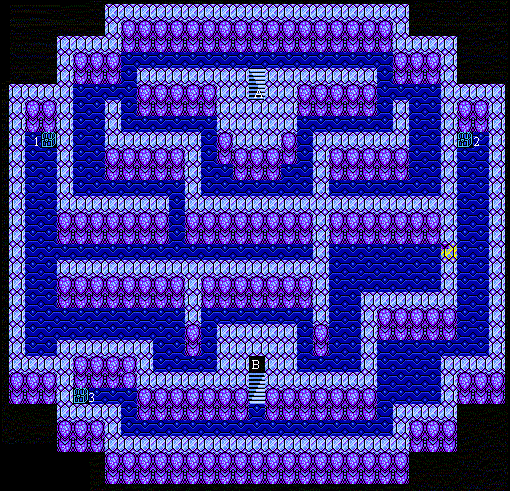
YAY.
Seriously though - I still enjoyed the challenge and thought it was epic. If you're going to hit me hard, you might as well go all out. Nothing in this game is held back. Also, the expanded job system allowed you to try out so many different things.
I tried for the longest time to play Final Fantasy III on an emulator but for some bizarre reason, I couldn't save, not even on save states. When I have the time, I definitely want to go back to that, try a different ROM or something, and experience the original. But I played enough of the original to know how hard it is. I died right away when I ventured outside the first town.
The DS remake mostly retains the difficulty of the original, which I admired, unlike the watered down PSP Anniversary Editions of Final Fantasy and Final Fantasy II.
Graphics:
The original Famicom game definitely has a lot more going on than the first two Final Fantasy games. Battles are still 90% black space but the rest of the game is 8-bit Heaven.
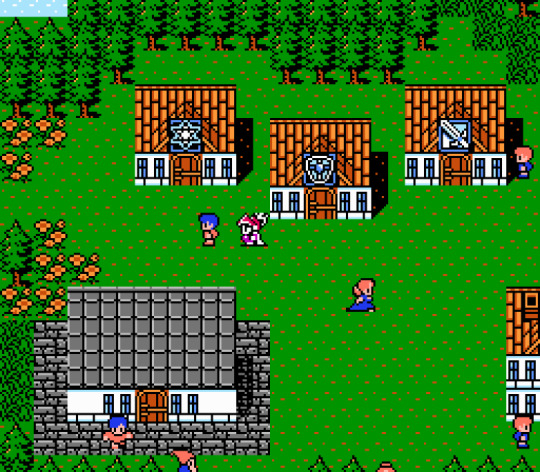
The DS remake is AMAZING. I would argue that Final Fantasy III DS is really the first great Final Fantasy remake. They got a chibi thing going on and it works here. It’s cute without being obnoxiously cute.
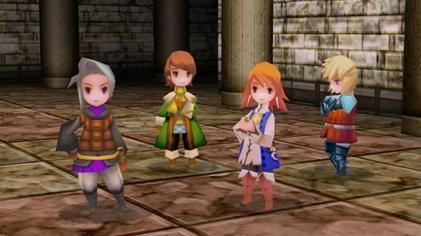
The FMV sequence for the DS is staggeringly beautiful.
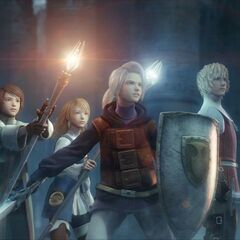
I also kind of laugh at this one part where Luneth and Ingus are arguing and it’s the equivalent to a stock photo of two people arguing.

I only wish they added an ending FMV. That would have been the cherry on top for the remake.
Story:
Final Fantasy III is kind of like crossing the original Final Fantasy with Final Fantasy II. The story is wider in scope and more epic. The fictional world is much more interesting. The score has a wider repertoire. You fly many different airships. It also begins what I like to call the "Crystal Trilogy." Final Fantasy III, IV and V, as you'll read later, are quite similar in their general plot, which utilizes crystals as important plot devices.
There’s more to the story than people give credit for. You venture into the world and run into secondary characters who have their own stories, such as Cid, Desh, Princess Sara (reference to the original Final Fantasy), Prince Allus, Priestess Aria, and even four imposters of the four heroes of light. You save towns with a variety of problems, from a village cursed by a genie to finding a missing precious stone for the dwarves. Then you discover the truth behind the world you live in. . .
The DS version elaborates on the story by giving the four orphans names: Luneth, Arc, Refia, and Ingus. This sharpens the story by connecting more dots. The DS story starts with Luneth and Arc as childhood friends. They later meet Refia, a runaway who was tired of her guardian's blacksmith trade, and Ingus, a knight of Sasune who protects Princess Sara. I was disappointed by one rather misleading thing in the DS remake. The opening FMV sequence seemed to imply that Priestess Aria plays a wider role in the story – she doesn’t. That disappointed me.
As I’ve said already, the DS version is a wonderful remake of the original. I very highly recommend it. It enhances everything about the original and more. The remake's heroes hardly get any recognition in other Final Fantasy media and that’s a shame.
Music:
As Final Fantasy games keep getting bigger, so does the score. Uematsu shone here. He did some unique things for a Japanese composer at the time. An example is the illusion of having chords in the track Crystal Cave.
Final Fantasy III’s soundtrack is twice as long as Final Fantasy II’s. I’d say that out of the entire Famicom/NES era, this game probably has the best soundtrack. The battle theme has a sexy bass with more drums added to it. Eternal Wind, the world map theme, is definitely the greatest map theme in an RPG. Period. It truly gives the feel of wandering around a fantasy world.
The DS version reinvigorates the entire score. I loved every second of it.
The way Uematsu composed the final of the epilogue is reminiscent of how John Williams does his finales in the credits for Star Wars or Indiana Jones films. In this case, he references the Final Fantasy Main Theme at the end of the credits.
The result is a wholesome feel to the game. Final Fantasy III has a fantastic score that is perfect for closing the 8-bit era of Final Fantasy.
Notable Theme:
I'm split between Eternal Wind and Priestess Aria's Theme. Fortunately, the DS opening cinematic includes both. It has a great orchestrated rendition of the classic themes.
youtube
Verdict:
The hardest out of all the Final Fantasy games (so far). At the same time, there’s so much to enjoy – but it’s not for everyone. Because of the difficulty, I would save this game for last. There’s something about this game that actually gives me a true “final fantasy” feel. The final stretch is so kick-your-nuts-hard that nothing else in the series can compare to it.
If you go for the DS version, however, that can be a tad bit easier. Just a tad. A smidge. Nothing more. It’s one remake that I highly recommend. They did a good facelift on both the game itself and the story. The DS version was adapted into Android and then ported into Steam, so you can get it there.
Direct Sequel?
No.
#final fantasy iii#final fantasy 3#final fantasy#black mage#red mage#square enix#nintendo#nintendo ds#video games#rpg#fantasy#magic#onvideogames
14 notes
·
View notes
Text
Final Fantasy X Review
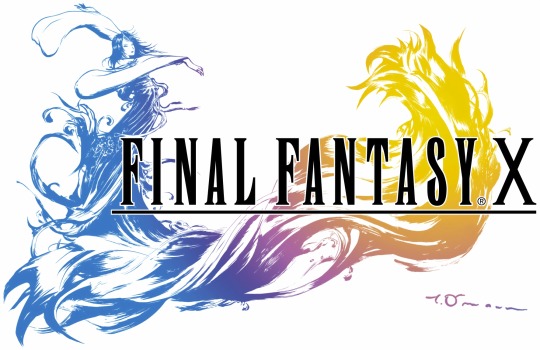
Year: 2001
Original Platform: PlayStation 2
Also available on: PS3 and PS4 (HD Remaster)
Version I Played: PlayStation 2
Synopsis:
Tidus is a renown blitzball player in the city of Zanarkand. One day, his mysterious buddy Auron whisks him away to the land of Spira after a massive entity known as Sin attacks Zanarkand. Tidus ventures into Spira, a strange world lacking in advanced technology. There, he finds many uncomfortable truths after joining a pilgrimage with the summoner Yuna.
Gameplay:
I will preface this by saying that this was my very first Final Fantasy game way back when I was like 13. I wasn’t keen on handling RPGs yet so it took me ages to finish. The result was me falling in love with everything about it. Final Fantasy X is the last main Final Fantasy game to feature turn-based combat. One of the coolest features of the battle system in this game is being able to switch characters in the middle of a battle. I missed that afterwards. When I played more Final Fantasy games after this, I kept thinking instinctively that you could switch characters in the middle of battle.
Leveling up is conventional but also introduces a Sphere Grid. You gain Ability Points to progress through a grid where each sphere unlocks a special ability or a higher stat. You can pick different paths along the grids and, typically, by the end of the game you are crossing over other character's grids.
The only truly annoying aspect of playing the game was the sphere puzzles in the temples. Every so often you have to enter a temple and solve a puzzle by placing spheres in the right places. It was so mind-numbing and the irritating music really didn't help either.

Because of how the story is told, the game is much more linear than its predecessors. The bulk of the game is spent journeying on foot across Spira. But don’t worry – there are plenty of secrets and extras to unfold – PLENTY. You eventually get an airship, but instead of flying around a world map you simply pick a destination on a map and you’re there. It sounds lame but the world is already so massive and detailed that Square probably couldn’t fit the graphics of flying around a world map.
Graphics:
The cinematics blew everyone away – because for the first time we have VOICE ACTING! JUST LIKE WATCHING A MOVIE! The voice acting worked really well in this game. It was only ever awkward when Tidus was being, uh, really annoying.
Exhibit A:
youtube
The in-game cutscenes can also be a bit stiff.
Story:
Final Fantasy X was my very first Final Fantasy game – as such, I could be biased in how I feel about it. Or maybe not. I’ve grown to be enough of a dick to crush my own dreams.
The story is completely different than the rest of the series. Completely different. While the rest of the series likes to make references to Western mythology and atmosphere (medieval and industrial settings), Final Fantasy X actually has an East Asian setting. There are no knights in armor or empires fighting rebels or even technological powers like Shinra. There are no witches or wizards. The story and references are quite esoteric, more mysterious and conceptual.

The narrative is radically different from the entire series. For the first and only time (so far), the main character narrates the unfolding events to the audience. After getting sucked out of his homeworld of Zanarkand, Tidus gets caught up in a pilgrimage to defeat Sin. Sin is a massive creature that returns every so often to punish the world for its dependence on technology. (So Sin is basically a kaiju.) A summoner with his or her friends go on a quest to defeat Sin, and the Calm returns for some time until Sin returns.

Spira is probably my favorite Final Fantasy world. It’s beautiful and haunting at the same, sad and bright. You can tell that there was once a great cataclysm but the long years have overridden the past. The rules of the world are so unique. Monsters are explained as the ghosts of people who have not passed on. A summoner this time not only summons great beings (called aeons) but also “sends” the dead away so they can find the Farplane, essentially Heaven. Like I said before, the concepts of Spira are very esoteric and East Asian. While Final Fantasy X does derive influences from Christian concepts (i.e. pilgrimage, priests, doctrines), it just as much references many Japanese and Buddhist concepts (rebirth, wandering souls, sacred temples). Overall, Final Fantasy X’s story is the most religious and spiritual in the entire series.
It’s relatively rare for a JRPG to take on an entire fictional world with a visual design referencing Asian settings. Usually, Final Fantasy and other JRPGs are more obsessed with Western settings (i.e. medieval towns). Spira is ripe with influences from island nations and places like Thailand and Bali.

The major plot twist require you to wrap your head around a bit, but surprisingly nothing is truly complicated. For the most part, you follow the story through the pilgrimage, learn some backstory stuff, and then face the end.
There are several “main” villains. For argument’s sake, and for the sake of not ruining any spoilers, let’s go with Seymour. Seymour is a recurring villain who again ups the ante on the bishonen trend. He’s also the biggest pain in the ass out of any Final Fantasy game. Ask anyone who has played this game and they will get Vietnam flashbacks of fighting Seymour. The bastard keeps popping up every so often to hinder the party’s progress. Seymour may look strange, but don’t let that fool you. He is also seriously one of the most fucked up villains in the entire series.

Tidus is unique in that he is an outsider viewing the story. He tags along and has his own story arc to deal with. Tidus’s story is one of the most personal and relatable. It’s so unique to play as a character who is not a conventional fantasy hero like a thief or a mage or a knight, but a sports celebrity with daddy issues.It’s also unique in that Tidus isn’t even the central character – Yuna is. Yuna is the summoner on a pilgrimage to defeat Sin. Even so, Tidus still plays an important role by falling in love with Yuna, influencing her goals on the pilgrimage.
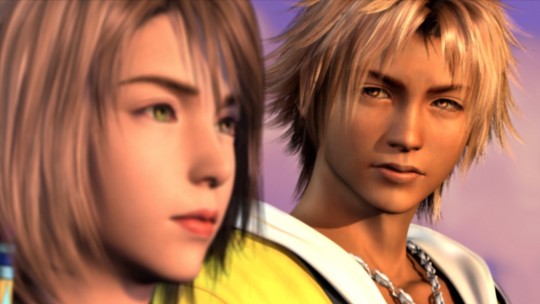
In retrospect, Final Fantasy IX appears to be a prototype to Final Fantasy X. Tidus is a version of Zidane, except, unfortunately, a bit more annoying when he tries to woo Yuna. Zidane and Garnet’s relationship mirrors Tidus and Yuna’s; both involve an upbeat male trying to woo a reserved, quiet female. Tidus is the temptation to Yuna’s repressed Catholic schoolgirl personality, advising her to loosen up. The existential crisis that Tidus faces is also similar to Zidane’s.
All that being said, Final Fantasy X is my personal favorite in the entire series. It has its flaws, and yes, it’s a sappy romance. But I love it. I fucking love it. I LOVE IT ALL. I love the world. I love the plot. I love the music. I love all the characters. Auron is so fucking cool. Just look at how cool this guy is.

And that ending. Oh man. I really don’t want to spoil anything but at the same time. UNGH. This game. It is poetry. Everybody is a real gangsta until they watch what happens at the end.
Final Fantasy X is probably the most unique out of all the Final Fantasy games. Different didn’t pan out well for Final Fantasy VIII. But for Final Fantasy X – different was good, really good.
Music:
Final Fantasy X does a few things radically different from its predecessors. For one, the series’ main theme isn’t featured. That may sound like blasphemy to some. In retrospect, it might have been a good move because frankly I can’t see the main theme being played anywhere in a story like this. The “Prelude” theme is only briefly featured in an opening menu, but this time it’s given a sick beat that makes you want to dance a little jig.
Alas, Nobuo Uematsu begins to detach himself from full reign of the soundtrack. Two other composers, Masashi Hamauzu and Junya Nakano, also co-wrote a bulk of the soundtrack. While Uematsu composed the main themes of the game, Hamauzu and Nakano composed many of the other tracks. While not everything they did was so different from Uematsu, there are a couple tracks, namely “Assault”, which is distinctly unlike something Uematsu would ever compose. I don’t say this in a bad way at all. The score is still golden. But after Final Fantasy X we see Uematsu depart, and Final Fantasy music starts diving fresh into the unknown.
The pop song for this score is “Suteki da ne”. It’s pretty good although I prefer “Eyes on Me” and “Melodies of Life”.
The HD Remaster soundtrack seems to skewer the original sound of the music. I’ve listened to it and was very displeased by what they did to “Assault”, which was one of my favorite pieces. The original soundtrack has more umph, more pomp and circumstance.
Meanwhile, “Otheworld” is a metal song – a first for the series. It plays in the opening when Tidus plays blitzball, and in one of the final battles. “Otherworld” is frequently misattributed to Rammstein, especially back in the days of Limewire. They had nothing to do with it. Uematsu composed “Otherworld”, and Bill Muir, a lead singer from the metal band xtillidiex, sang it.
Uematsu’s fully orchestrated work on the ending scene is masterful. The emotion behind it brings tears to my eye. It wrecks you, man. It pulls those heartstrings and doesn’t let go. It hurts so good to listen to it and remember how the story ends. It is the most emotional track for the most emotional Final Fantasy ending. It is here where you realize that Nobuo Uematsu could really be a movie soundtrack composer. His craft came full circle here.
Notable Theme:
“To Zanarkand” – the main theme of Final Fantasy X. Beautiful, gentle, and solemn.
youtube
Verdict:
Final Fantasy X is my personal favorite. Final Fantasy VI can objectively be called the best, but I have a soft spot for Final Fantasy X. I admire its unique story and its world. It can be campy and corny at times but I love it overall. Objectively, it’s still of a higher caliber in the series.
Direct Sequel?
Yes. Final Fantasy X-2, or also known as Final Fantasy X-2: For Fangirls Who Couldn’t Handle the Ending to X.
I kid. That was harsh.
But I mean. . .
They gave this Charlie’s Angels vibe with Yuna, Rikku and this new girl Payne.
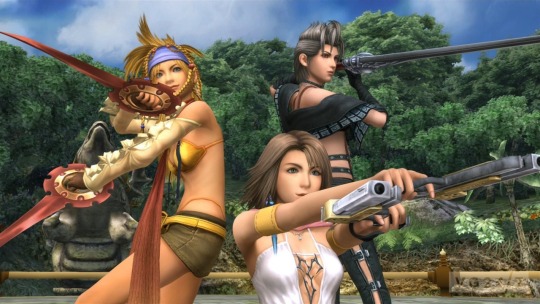
And like I guess it’s cool but like the tone is soooo campy.
And then they sing and it’s like J-Pop and . . .
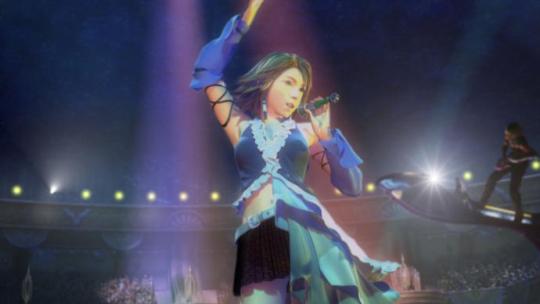
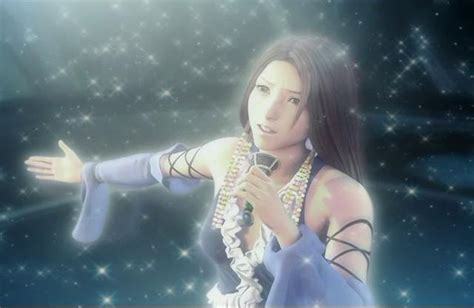
Yeah.
This was the sequel.
This was the first Final Fantasy sequel ever made.
And it was. Uh. It was something.
At the time, I could only play about a quarter of the way through before feeling wrong about it. Many critics would agree that it robs the dignity of the original game. I do want to actually try playing it again. I might come into it with a new mind. But. Still. I prefer they leave the original ending untouched.
#final fantasy#final fantasy x#final fantasy x-2#yuna#tidus#final fantasy tidus#tidus x yuna#square enix#fantasy rpg#jrpg#video games#onvideogames
13 notes
·
View notes
Text
Final Fantasy IX Review
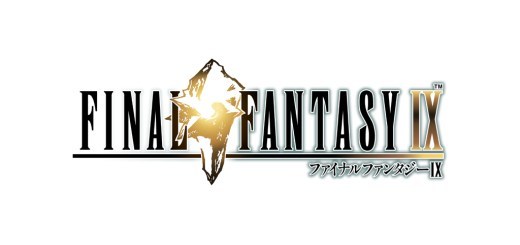
Year: 2000
Original Platform: PlayStation One
Also available on: PC, Android, iOS, Steam
Version I Played: PlayStation One
Synopsis:
Zidane Tribal is a thief whose troupe is hired to kidnap princess Garnet Til Alexandros XVII. The world is in the midst of a war, and Garnet is pleading with her mother, Queen Brahne, to stop it.

Gameplay:
Final Fantasy IX returns to more traditional gameplay. Active Time Battle. Each character has a unique ability. Summons come in the form of “eidolons.” Limit Breaks are now called Trance Modes.
There’s also a mini card game called Tetra Master – which is super fun. Final Fantasy VIII also had a card game named Triple Triad, which I think gamers like more, but I never touched it.
I have very fond memories of Final Fantasy IX, both in gameplay and story. I devoured this game throughout my entire junior year of college. As such, I associate this game with many fond memories. I finished this game on literally the final day of junior year as people were packing up to leave.
This game as often been referred to as the prime example of Final Fantasy – again, both in gameplay and story. It has the highest metacritic score of all the Final Fantasy games. Yet at the same time, it’s sorely underrated. Not many people talk about it.
The difficulty wasn’t hard to grasp – at least for me. I didn’t die until the penultimate battle. I would suggest it as an option for a beginner.
Graphics:
Imagine Final Fantasy VII but way more defined. Square returned to the cartoonish world and left the realistic world from Final Fantasy VIII alone. The graphics and style are awesome. Each town is so pretty and cozy.


Final Fantasy IX wraps up the series for the PlayStation One – and it’s a blast. It went all out with the system’s capabilities.
Story:
Final Fantasy IX goes back to the basics after Final Fantasy VIII. It’s also quite refreshing. Final Fantasy VIII was written so bland and without depth, whereas Final Fantasy IX is alive with colors, characters and stories. It has the most diverse cast in the series – just look at these dudes:
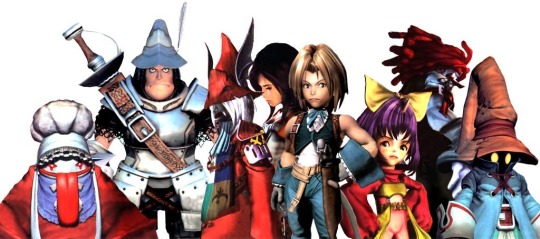
All of them have something to offer. The fan favorite is typically the black mage Vivi – whose backstory is memorable for the philosophical questions it poses.

The story is a perfect example of how tropes can still feel refreshing because of how the story is told. I like how the story’s biggest themes deal with the nature of a soul. Out of all the Final Fantasy games, the existential crisis here hits the hardest, like a thesis for a philosophy class.
Zidane hearkens back to the friendlier protagonists rather than the standoffish, brooding types seen in Final Fantasy VII and Final Fantasy VIII. However, while Bartz from Final Fantasy V was a goofy drifter and Locke from Final Fantasy VI was a charming rogue, Zidane introduces the cheeky and H O R N Y protagonist. This can make you roll your eyes as he constantly tries to hit on the main female lead, Garnet. This one scene in particular didn’t age well.
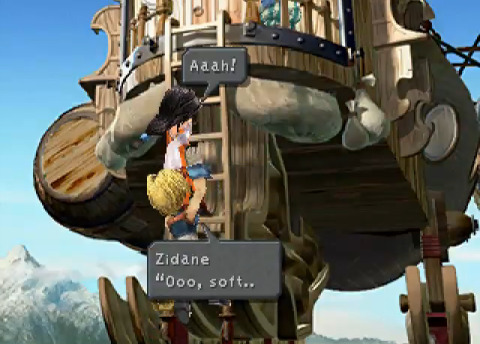
The romance between him and Garnet is the exact opposite of the romances in Final Fantasy VII and Final Fantasy VIII. Instead of the female lead flirting with the male lead, being the one to change his life, the male lead flirts with the female lead. Zidane's role as a romantic is to “show her the world” á la Aladdin and Jasmine. Zidane is a devil-may-care thief with his band of rogues, wishing to show Garnet an exciting life by his side.
It was unclear to me at the time why Final Fantasy IX fell into the more underrated side of Final Fantasy. In retrospect, Final Fantasy VII still took the world by storm, and Final Fantasy VIII still came off as a lot “cooler”. Some critics complain how the main villain, Kuja, is the least threatening villain of the entire series. Kuja’s bishonen level is over 9,000. Look at this guy. He belongs on the cover of Vogue or something.

Gamers at the time probably felt that Final Fantasy IX wasn’t as amazing or intriguing since it returned to the tropey elements of the series, after we had seen two big games set in a modern technological world.
But like I said, Final Fantasy IX manages to use these tropes and make them entertaining. Vivi’s character arc? Oh man. I really don’t want to ruin it. It’s that good. They say Final Fantasy IX is the closest to how the developers originally envisioned the world of Final Fantasy. The definitive version of Final Fantasy.
Music:
Surprisingly, the music is the weakest part of the game. When I thought about what to write about for the music section for this game, I stared into space as crickets chirped in my head. I can only think of the title theme (”The Place I’ll Return to Someday”) and “Melodies of Life”, another pop song.
I like “You’re Not Alone” but I didn’t pay attention to it until I listened to the orchestrated version on the Distant Worlds album.
The answer then hit me as to why the soundtrack flew under my radar – the score takes an almost purely instrumental route, drawing inspiration from classical music. Most of the inspiration is specifically from medieval music, given the setting of the game. It’s not a bad thing, but Nobuo Uematsu’s signature progressive rock style is notably absent in everything except the battle theme. As such, nothing struck out at me. Nothing told me, “WOW. You just HAVE to listen to THIS!” I hate to say it, especially because Uematsu himself has stated that this soundtrack is his favorite work and the one he is proudest of.
The next time I play this game, I will pay more attention to the soundtrack.
Notable Theme:
As I said before, I associate Final Fantasy IX with fond memories of my junior year in college. “Melodies of Life” gives me all the feels. It has that late ‘90’s slow-dance feel.
youtube
Verdict:
Great game. Underrated. I can sum it up by saying - it doesn’t do anything new per se – it just shines as a Final Fantasy game using all of the series’ classic elements. It doesn’t do anything crazy, but it creates a lush vibrant world of pure medieval fantasy, and its characters go through a lot of depth.
Direct Sequel?
Nope.
#final fantasy#final fantasy ix#zidane tribal#garnet til alexandros#dagger final fantasy#garnet final fantasy#garnet#square enix#video games#onvideogames#rpg#vivi#kuja#final fantasy vivi#final fantasy kuja
10 notes
·
View notes
Text
Final Fantasy II Review

Year: 1988
Original Platform: Famicom
Also Available on: GameBoy Advance (Final Fantasy I &II: Dawn of Souls), PlayStation One (Final Fantasy Origins), PSP (Anniversary Edition), Android, iOS. Wii/3DS/Wii U Virtual Consoles and WonderSwan Color releases are only in Japan.
Version I Played: PSP
Synopsis:
Firion, Maria, Guy and Leon are recent orphans from Emperor Palamecia’s attack on the city of Fynn. They are picked up by Minwu, an agent of the rebellion against the Emperor led by Princess Hilda. The orphans wish to join the fight against the Emperor, and so Minwu helps them on missions to foil the Emperor’s plans.

Background:
So, here's where the history of Final Fantasy games gets a little choppy. Final Fantasy II was not initially released in the US, nor outside Japan for that matter. The reason was because the US localization was taking too long and the Super Nintendo was already being developed and on the verge of released. The same thing happened with Final Fantasy III. The US localization for both games were trashed in favor of working on Final Fantasy IV. Square released Final Fantasy IV as Final Fantasy II for Western audiences, so they wouldn't get confused. Final Fantasy V was also unreleased outside of Japan for other reasons, and so Final Fantasy VI became known to Western audiences as Final Fantasy III.
Then when Final Fantasy VII came around they said "Fuck it" and left it numbered like that for Western audiences too.
The real Final Fantasy II wasn't released to Western audiences until 2003 with Final Fantasy Origins for the Playstation One. The real Final Fantasy III wasn't released to Western audiences until the 2006 remake for the Nintendo DS. Final Fantasy V was first released outside Japan as part of the collection in Final Fantasy Anthology for Playstation One in 1999.
Gameplay:
Final Fantasy II is the black sheep of the series. Even though it sold well on its first release, it’s the lowest selling Final Fantasy game to date. This is in part to the gameplay, which sounds great on paper but doesn’t work out well in execution.
Instead of conventional leveling up - meaning you gain experience points (XP) and your stats rise - you raise your skills and stats based on how often you use them. Everybody has the ability to use any weapon or magic spell. But the more you use one certain weapon or certain spell, the more you level it up. For example, I could have Firion use a sword. The more often I make him use a sword, the greater his skill with a sword. If I give him an axe, he will start with a Level 1 axe ability, and not deal as much damage as he would with a sword.
The problems arise in matters of defense and HP. By that logic, the more you get hit, the more your HP grows. This is pretty infuriating because if you want to grind to raise your HP, you fall in danger of dying. To raise defense, you have to equip a shield and get hit. It also really sucks late in the game if you neglect one particular stat that becomes important.
By the time I reached the third act of this game, I was frankly fed up. I just had the sole purpose in mind of finishing the game. The frequent random encounters near the end infuriated me. Not that they were hard, but they used up my resources and I really wanted to end it once and for all.
However, the game has a nice feature where you can learn key terms and words when talking with people. This helps you remember what to do and where to go next. That part was cool.

Graphics:
Very little had changed between the first and second Final Fantasy games, as you can see.
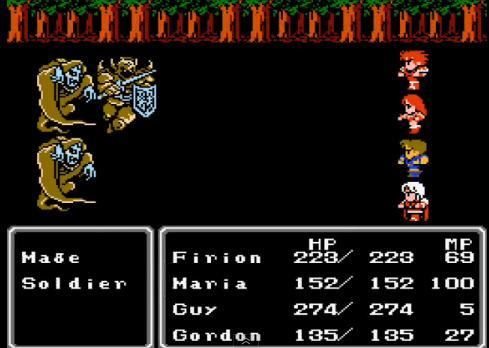
The same is true for the PSP Anniversary Edition.

The graphics are exactly the same as that of Final Fantasy PSP Anniversary Edition. As such, they feel homogeneous and somewhat uninspired. Once again, they rip the opening FMV sequence from the Playstation One version. Why do they do that? Just give a little extra effort to make it unique. Just a little.
Story:
Final Fantasy II was the first story-driven RPG for the series. It introduced a lot of the trademark elements that the series is known for, like Cid and Chocobos, and so it’s a shame that it wasn't memorable.

Critics bash the story because they compare it to Star Wars from 1977. The plot is similar in that there is a rebellion against an empire and a princess who gets imprisoned inside the empire’s secret weapon of mass destruction. The Emperor even has a right-hand man clad head to toe in armor with a SECRET IDENTITY. While there is no Death Star in Final Fantasy II, there is a massive airship that the Emperor builds to crush the rebellion - the Dreadnought - and Princess Hilda, just like Leia, is taken prisoner there.

But in my opinion, plot parallels should really be the least of your worries. I think the story is a tad bit underrated. Just a tad. Well, the main characters are bland. Firion is a cool name. Other than that, there's nothing to say about them. They are less fleshed out than the secondary characters, which is ironic. I was more interested in any other character than the main cast. Guy (or Gus in some versions) is a stereotypical friendly giant, only saying short phrases or one-word answers. Firion and Maria don't really do much except want to fight for the rebellion. Leon has a story arc that's too quick and convenient.
The secondary characters that you run into are much more interesting – Josef, Minwu, Gordon, Ricard, Leila and Scott. They come and go during certain events and they all have even the slightest ounce of backstory more than the main characters.
The story tapers off after you rescue Princess Hilda. While I won’t spoil anything (though I doubt you’d care but still), there are stupid moments when the Emperor could have easily crushed the rebellion but instead chose a different route. Ultima, the ultimate spell, becomes an important plot device that the heroes seek – and yet it doesn’t end up being effective for the final battle nor is it mentioned again in the story. Overall, Final Fantasy II appears to be the Final Fantasy game with the most plotholes. The strongest part of the story lies in its secondary characters. The game left me wanting more of them instead of playing a group of stereotypical orphans without any personality.
Even though Final Fantasy II has an actual storyline, its predecessor feels much more original despite the fact that it’s more like a series of episodic events. Whether Star Wars was an intentional inspiration or not, it makes sense as a first jab at creating a storyline. It’s simple and tropey.
Music:
Despite Final Fantasy II lurking in the shadows for years, it has good music. The Rebel Army theme is great, especially when you hear it orchestrated in Final Fantasy medleys and the Distant Worlds concert. The final battle with the Emperor has the first true final battle music in the series, and it’s awesome. You can tell Uematsu had fun expanding his repertoire.
Like before, the PSP version adds more tracks and gives a more orchestrated feel.
Notable Theme:
As the chocobos debuted in this game, so did their theme song, which was quite repetitive here. In later games, Uematsu added another stanza of music.
youtube
Verdict:
Most likely the worst of the Final Fantasy games. You’re really not missing much if you never play it. It strikes a jarring note in both gameplay and story, like when you play the piano and keep hitting the wrong key.
The PSP version is probably slightly more interesting. Still, I wish they buffed up the story somehow. Why not remake the entire game? There is potential with the characters. Keep your basic elements but just make the story, you know, not boring and stupid.
Direct Sequel?
Yes. Final Fantasy I & II: Dawn of Souls introduced a second part to the story called Soul of Rebirth. The PSP version also has it. It's dumb. I tried it and for whatever reason it’s very difficult right away and so I lost interest entirely.

#final fantasy#final fantasy ii#firion#final fantasy maria#final fantasy minwu#minwu#final fantasy leon#final fantasy guy#final fantasy review#square enix#square#sony playstation#nes#famicom#video games#onvideogames
6 notes
·
View notes
Text
Final Fantasy VIII Review
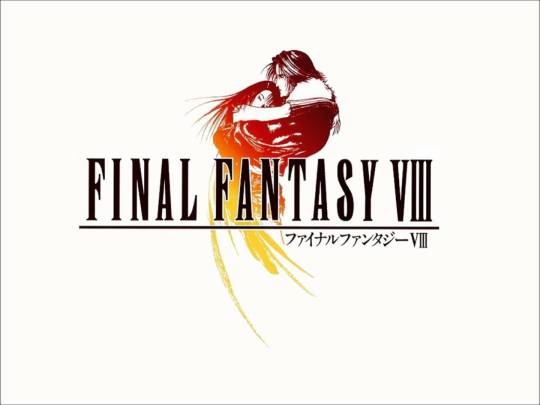
(A serious review this time, without spoilers.)
Year: 1999
Original Platform: PlayStation One
Also available on: PC, PlayStation Store
Version I Played: PlayStation One
Synopsis:
Squall Leonhart is a new recruit of SeeD, a mercenary team protecting the world. Rinoa is a resistance fighter against the Republic of Galbadia, led by the Sorceress Edea who is suddenly hellbent on conquering the neighboring nations. Squall and his team attempt to assassinate Edea, but the mission goes awry.
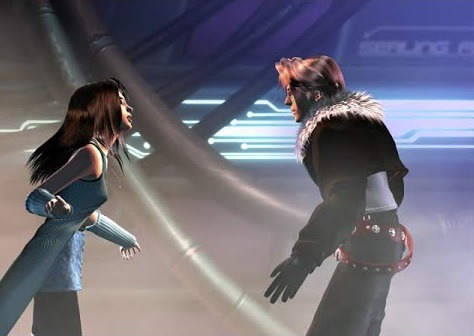
Gameplay:
Final Fantasy VIII throws nearly every previous battle system out of the window. It’s nearly as radical as Final Fantasy II’s battle system. Enemies around the world map average their levels according to your average level among your characters. You only need 1,000 EXP (experience points) to rise to each level, unlike the other games where the EXP needed rises after each level. But that doesn’t mean your character levels up all their stats – that all depends on the summons, known in this game as Guardian Forces.
Unlike other games, summons are crucial to the gameplay, despite not being crucial to the story itself. The Junction System has you “junction” each character with a GF, allowing you to assign different battle commands (Item, Draw, Magic, GF, etc). If you don’t assign a character a GF, all they can do in battle is “Attack.”

That gets super annoying when you’re moving around GFs between characters a lot but you forget to assign that one character a summon right before a major boss battle, so then they can’t do shit.
The drawing system is my favorite aspect of Final Fantasy VIII’s gameplay. Instead of harnessing magic by a points system (such as MP), you draw magic from enemies. Magic is only limited by the number of spells. For example, you fight an enemy and draw 5 Curas from them. You now have 5 Cura spells. You can hold up to 99 of any spell. You don’t have to worry about ethers or running out of MP. I guess it’s an incentive to battle enemies, as they are resources for magic.
But the way the GFs work annoy me the most. You to call upon GFs at any time in any battle for an infinite number of times. This doesn’t give you any incentive to even try battling. If something annoyed me, I just said, “Fuck it” and spammed GFs. Not only that, but you have to sit through the short cinematic sequence of your summon every time you call them. I must have viewed Shiva’s summoning sequence ten-thousand fucking times before finishing the game. This makes battling feel repetitive, tedious, and unenjoyable. Battling was a chore.
The Junction System overall is so complicated that you have to go through a tutorial within the first twenty minutes of the game. It’s aggravating enough already to sit through Quistis going, “Blah, blah. blah” but it’s actually super important because if you don’t pay attention then this game will be tedious.
The final battle though? That shit was epic. Hard. But epic. One of the best final battles.
Graphics:
This game took a different route in giving realistic proportions to its characters. While that’s a cool idea on paper, the overall effect is. . .boring? Almost every other Final Fantasy game has a cast of very distinct characters, like various species, age groups, or wildly different clothing. To suddenly play a Final Fantasy game with what looks like real people – like Bob, Joe and Jill – seems drab. Selphie by far has been the least interesting character to me. When your characters look and feel like NPCs, it’s hard to become invested in them.
I wasn’t a fan of many of the backdrops because for whatever reason I had trouble discerning some doors. I couldn’t tell what I was looking at in the background sometimes, like if there was a switch or button that I had to press.
The cinematics are great though – some of the best in the series. It has the most memorable opening sequence of any game – the duel between Squall and his rival Seifer. The cinematics were a MAJOR step up from Final Fantasy VII.
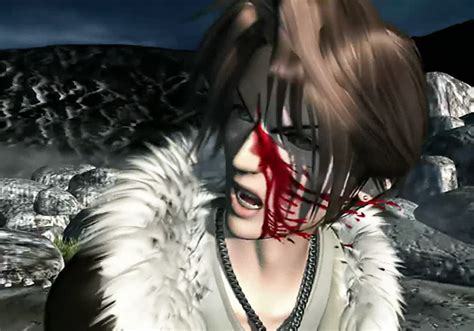
Story:
Oh hey, so here’s a serious, non-spoiler, non-inflammatory review of Final Fantasy VIII.
Put this story side-by-side with Final Fantasy VII and you can see how they carried on the inspirations. Once again, the story is set in a more modern setting with cars, trains, etc. Squall is Cloud. Rinoa is Aerith. Etc., etc.
Squall Leonhart is the epitome of angst. You will spend the entire game rolling your eyes at Squall’s angsty introspective thoughts about the situations he’s in and people around him. Squall is essentially a bad version of Cloud Strife from Final Fantasy VII. Take Cloud but only take his cool design and angsty responses. That’s Squall Leonhart. Squall literally has no interesting qualities about him other than his physical design. He can rock that jacket and that scar on his face. Squall’s “romance” with Rinoa Heartilly is also a cardboard copy of Cloud and Aerith’s romance. Squall meets Rinoa by a chance meeting at a military ball. She serves as the optimistic, lively counterweight to Squall’s stoicism. But there’s hardly any depth other than Squall finding her pretty and Rinoa thinking he’s cute and handsome.
The cast of characters is bland, to say the least. They are composed of other students (Quistis being an instructor though) at Balamb Garden (except Irvine, who is a student of another Garden). They look boring. Their introductions are boring. Balamb Garden sounds like a cool idea – a mercenary school – except it plays off more like a poorly written high school anime drama, which is lame. At one point, Squall’s friends – Zell, Selphie, Irvine and Quistis – all try to conspire to get him to talk to Rinoa. You actually have to play through that of the plot and watch it unfold. But Squall tries to understand Rinoa’s upbeat attitude with lots of question marks in his thought bubbles and mumbling, “Whatever”. It’s jarring to sit through four discs of this over and over.
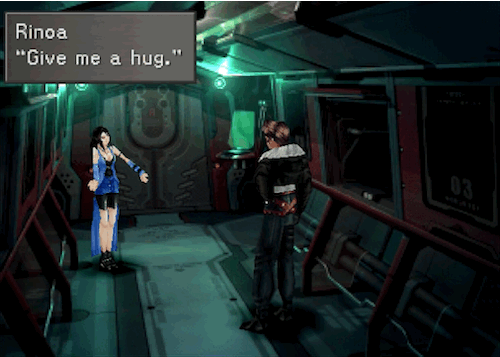
The plot is a butchered mess. After Disc 1 is when the plot gets strange like a fever dream. Plot twists happen left and right after Disc 1 without any rhyme or reason. Very little is explained and many twists are too convenient. Seifer is introduced as Squall’s rival and Rinoa’s original love interest, but then he inexplicably turns evil. In no dialogue or plot points do we ever learn why Seifer switches sides. None at all.
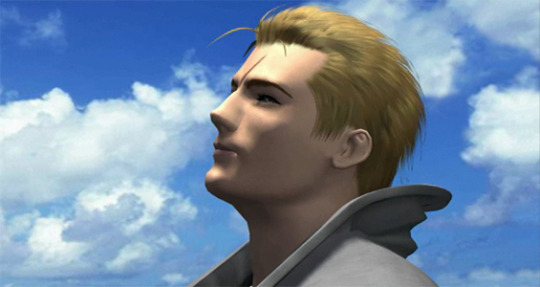
There’s a particular interesting fan theory that actually makes infinitely more sense than the story that Square gave us. Here’s a hot tip – when fan theories start making perfect sense, you probably didn’t write a good story.
The best part of Final Fantasy VIII is actually Laguna Loire. Throughout the story, Squall and his friends pass out for mysterious reasons and you are introduced to Laguna Loire and his two buddies, Ward and Kiros (who are reminiscent of Biggs and Wedge from Final Fantasy VII). They partake in events set in the past. Laguna Loire hearkens back to the pre-Final Fantasy VII heroes – heroes like Bartz and Locke. He’s funny and charming. I wish the game was about him and his friends instead of angsty Squall and his cardboard friends.
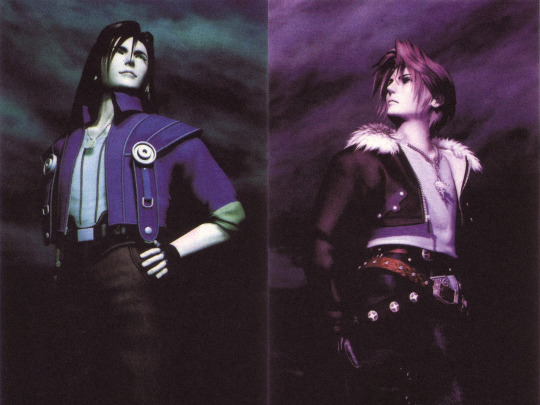
So, for four discs you play through these parallel plots and then they merge by the end. The payoff isn’t so amazing. I expected something better. Time travel is involved, albeit in a way that doesn’t make sense. Time compression! The ability to compress time into a singularity because . . . because why again? I guess you don’t have to wait for the next season of Game of Thrones anymore. Is that what that means?
Other notes I want to mention – Balamb Garden is an awful, clunky airship and the world map is the least interesting world map in the entire series. The only remotely interesting place is Fisherman’s Horizon.
Final Fantasy VIII’s story is the second most radical departure from the series, the first being Final Fantasy X, which I will get to later. However, Final Fantasy VII lacks any meaningful depth or existential crisis for its main character to explore. There’s no grand critique on the meaning or life or anything like that. There’s one slight existential question that Rinoa faces near the end but it’s practically nothing. I admire what they tried to do but it fell flat on its face. It’s dull and insipid with its characters and the plot doesn’t steer in a clear direction.
Overall, I admire what they were trying to do by adding time travel to the story. But it became such a warbled mess that it failed to deliver. They took all the cool parts of Final Fantasy VII but didn’t bother to give them depth.
Music:
The music is the biggest highlight of Final Fantasy VIII. Laguna Loire’s battle theme is sexy as hell. It made me so sad to return to Squall’s timeline, because I wouldn’t get to hear that music again for a while. The world map theme irritated me. It has a jingle that didn’t jive well with wandering around. It probably also didn’t help that the world map is dull to run around in.
The game’s theme, Liberi Fatali, is damn epic. Liberi Fatali does have actual lyrics but the famous lines “Fithos lusec wecos vinosec” is actually nonsense. Maybe that nonsense reflects the nonsense that is the actual story. It would have been nice if they had actually incorporated those words into the story somehow, like some magic spell like “abracadabra”.
The love theme is Eyes on Me, performed by Faye Wong. It’s the first time that Uematsu composed a pop song for a Final Fantasy game. Its lyrics are nice and of course fitting for the love story. I like hearing it.
There are no other character themes in this score. The focus was all on Squall and Rinoa having their silly angsty romance.
The final boss theme is actually one of my favorites. It starts out eerie with the chorus singing “Fithos lusec wecos vinosec” but in this drawn out, ghost-like manner. Then the music picks up sounding like a typical Final Fantasy battle theme, then goes crazy from there on out.
Notable Score:
Liberi Fatali.
youtube
Verdict:
My least favorite Final Fantasy game. I would place it right at the bottom tier. The story is absolute gibberish. The gameplay could be fun once you wrap your head around it, which I didn’t and so it was a pain in the ass for me. Finding all the Guardian Forces can be fun. Laguna Loire is the best part of the story, and that’s really it. At the end of the day, probably put this one off until you play the better, more important Final Fantasy games. You are not missing anything if you never play this game.
Direct Sequel?
No.
Keep it that way.
#final fantasy#final fantasy viii#final fantasy 8#squall leonhart#squall x rinoa#rinoa heartilly#video games#onvideogames#fantasy rpg#sci-fi rpg#science fiction#balamb garden#quistis trepe
5 notes
·
View notes
Text
Final Fantasy Review
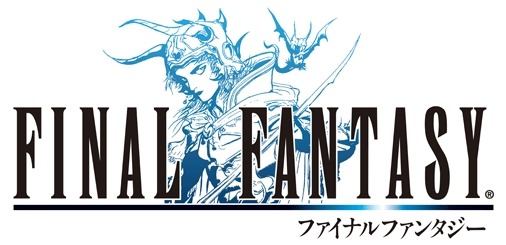
Year: 1987 Original Platform: Famicom Also available on: Nintendo (NES), GameBoy Advance (Final Fantasy I & II: Dawn of Souls), PlayStation One (Final Fantasy Origins), PSP (Anniversary Edition) Version I played: PSP
Synopsis:
The world is in danger. Four monstrous fiends, each corresponding to an element of nature, have wreaked havoc on the world, causing each of the four elemental orbs (in later remakes, crystals) to turn dark. Four Heroes of Light, each holding their own orb, meet and band together to take on these fiends and restore nature to its proper balance.
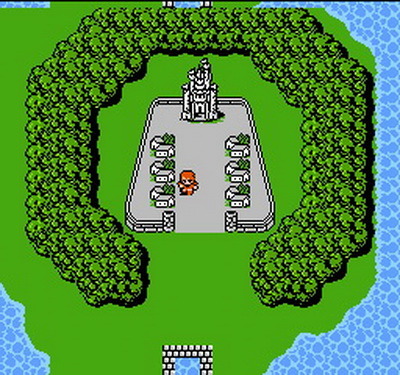
Gameplay: The original game introduced the Job System. The six jobs are Warrior, Thief, Monk, Black Mage, White Mage, and Red Mage. Each have their own stats. You are free to name each of your heroes. Later on the game, each job can be upgraded.
We are introduced to a classic setup of turn-based combat. Final Fantasy was notable for being the first video game RPG to show your characters on the right and the enemies on the left; all previous video game RPGs had a first-person view with the enemy directly in front of you.You choose your action between Fight, Magic, Drink, Item or Run. Then the enemy takes their turn.
It’s a simple system that at the time was already well-known. It was really the Job System that intrigued players. Black Mages perform destructive magic, White Mages heal and restore, Warriors are the powerhouses, Monks deal damage without weapons, and Thieves can run from battles successfully (they cannot steal, as later games would introduce that). The game can be quite difficult on the original Famicom and NES. It was made at a time when technology was limited, so developers had to make the game harder so that people spent more time playing it. There’s a gaming term that I’ll be using in many of these Final Fantasy reviews called “grinding”. Grinding is when you end up having to run around and fight monsters for the sake of leveling up your characters. There is a lot of that in this game, as well as the early Final Fantasy games in general. Unlike games today, the direction isn’t fully laid out. You are thrown into the world and wander about from town to town to figure out where to go next. Instead of games like today where other non-playable characters (NPCs for short) tell you what to do in cutscenes and whatever, you actually have to approach the NPCs and find out the information. The overall effect is more open-world. You walk across fields and oceans and deserts. There are caves and other secret places to find more items. From a modern gamer’s perspective, the exploring can be quite bare and – for lack of better word – boring. The remakes, like the PSP version that I played, brightened it up with updated graphics. They also added a couple extra dungeons. I actually spent time in those extra dungeons believing they were part of the story, appalled by how difficult they were, when I later found out they were extras put in for the PSP version. That has happened a lot to me with remakes of old RPGs (Chrono Trigger for the DS, another example). A little more obvious sign would have helped to make me realize that I didn’t need to finish those extra dungeons. The pace is definitely slower than the other Final Fantasy games. Most of your time is spent grinding. Grinding can sometimes be a wary word when talking about video game RPGs. If an RPG is too boring or tedious, grinding is the last thing you want to hear. But even when an RPG is fun, grinding means that you need to spend time battling enemies, and that means hopefully you don’t have a huge backlog of other video games. It's probably why I never got around to finishing the original NES version on an emulator. Once and a while I'd be pumped up about going through with it but then as I played I just. . .got distracted by other video games that I wanted to finish.
You definitely need time and patience. The most aggravating thing about the original version (Famicom/NES) is that if your character is set to attack an enemy but another one of your characters defeats it first, that character attacks nothing but air when it's their turn. It was a very annoying issue that they fixed in all subsequent remakes. When comparing the original to any other version, the original always is the best way to experience the game. It can also be the hardest and most time-consuming. You would need to pay attention to this game entirely and not be distracted by anything else.
The PSP version is watered down. I found it infinitely easier than the NES version. I actually played them side-by-side to figure out at what point the difficulty branched off. Right away when you venture to save Princess Sara, I realized that the PSP version gives more XP per battle than the NES version. Hence, you have to grind more in the original version.
Graphics:
Everybody loves some 8-bits, but let’s be honest here – there’s a whole lot of black empty space going on when you battle.

But hey, that was due to the limitations at the time. Battles may seem more boring to you due to the lack of detail to catch your eye.
The later remakes added a floor or ground where appropriate. The PSP remake did a good job of giving a facelift to the original, as shown below. It has this cute, rounded feel to the characters.
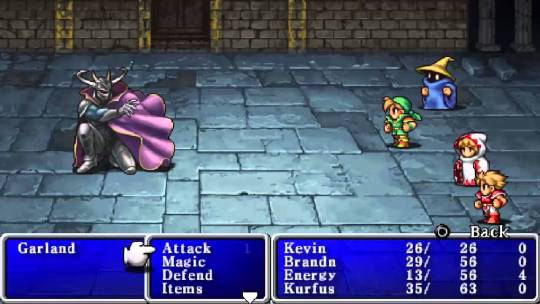
(My favorite battle background was in the final battle.)
The opening FMV sequence is ripped straight from the Playstation One remake. That didn’t age well. It’s awkward as hell. Want to see how awkward it looks? It looks mad awkward. Don’t say I didn’t warn you. Just look it up. I don’t want to sully this post by posting a screenshot. In my opinion, they should have created a brand new opening FMV sequence for the PSP version.
Story: The first several minutes of the game acts as a prologue. The Four Heroes of Light save a princess - Sara - from the clutches of Garland, and then the King of Coneria allows a bridge to be built for them to enter the world and save it. It’s not until that bridge is built that the game truly starts and the title screen actually displays – much like a late opening title in a movie. In retrospect, saving a princess probably seemed like the most common trope in video games throughout the '80's. Gamers would have been used to it by then. That short prologue acts like a trope-breaker. The average gamer would have probably expected the game to be like Mario or Zelda. Oh yeah, save the princess from some evil fiend, okay, got it. They would have then maybe been perked with interest when they "defeated" Garland so quickly, and then when the King of Coneria lets them pass into the world and the title screen opens up with the theme song, they maybe were like, "Ooooh. NOW it starts." Final Fantasy then plunged them into a wide open world.
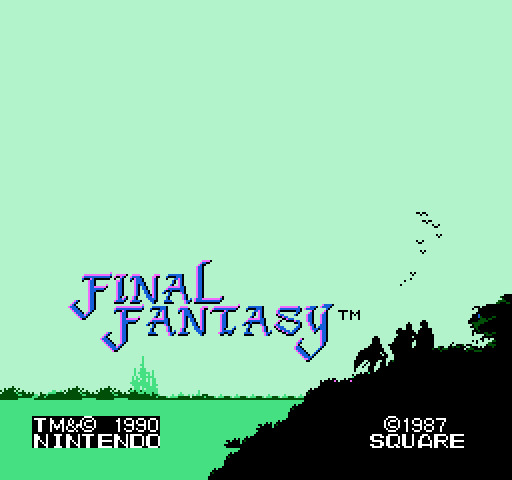
The bulk of the story is mostly comprised of self-contained incidents. You run into someone who needs help with a thing so you do that thing and then you’re on your merry way again. You know what would be a great adaptation of this game? A Netflix series. It’s very episodic. First you deal with these pirates led by Bikke, then get a ship to sail across the land and go on a sort of delivery quest for a crown, a crystal eye, an herb, a magic key, until the main story picks up with defeating the Four Fiends and bringing light to the darkened orbs. There's no real huge spoiler other than the time travel paradox at the end, which had me wracking my head a bit. It's quite admirable that a game this early in video game console history produced a higher concept plot involving time travel. Music:
Composer Nobuo Uematsu created a legendary score that immediately became on par with the Mario and Zelda theme songs. The Prelude/Crystal theme – the harp-like scale that we are all familiar with – was actually composed last. Uematsu had complete the score when Sakaguchi approached him at the last minute realizing they needed music for the game’s introduction. None of them had any idea that the theme would become a staple for Final Fantasy.
Due to the technical limitations at the time, you can imagine that the soundtrack is limited, but even so it was still quite expansive for its time. There are several individual tunes for dungeons, for sailing your ship and for flying your airship. The map theme will have you humming it without realizing it.
Uematsu drew his inspiration from two sources – classic rock and living in Shikoku, an island off Japan. The melodic world map theme in Final Fantasy (and the rest of the series) derives from the picturesque memories he has of the island. The town theme is reminiscent of the sleepy villages – as he was never a city person. Meanwhile, the battle theme has undertones of rock music.
There’s only one battle theme, even when fighting bosses and the final boss, but the amazing thing is that it never gets old.
Final Fantasy games are known for their great battle songs. The opening bassline always gets you in the groove to fight. You’re fighting but want to sing at the same time. Maybe that’s the brilliance of Uematsu; because of the fact that you need to grind many times in these old Final Fantasy games, he created a tune that you wouldn’t get tired of because it’s not so serious or mundane.
Not to crap on other great developers, but other video game RPGs at the time of Final Fantasy didn’t quite have memorable battle music. Just look up the battle theme to the first Dragon Quest game (released before Final Fantasy). You can imagine how that simple tune could get old really quick. I could be pulling this out of my ass, but after Final Fantasy, it seemed that battle music in video game RPGs suddenly got better. If you listen to the Dragon Quest IV battle theme, there is a portion that sounds similar to the battle theme of Final Fantasy.
The PSP version adds more tracks, specifically to the boss battles, and I like how they incorporate the original battle motif thrown into the new battle songs. The original battle theme has a guitar and drums added, which is the style that Final Fantasy battle music was known for by then.
There is one last thing to note about the score that I found very interesting for its day and age. You see, in a movie score, you have themes and motifs, just like a video game score. But in a movie score, other tracks reference those themes and motifs. For example, you have The Raider’s March in the Indiana Jones films; that’s the theme for the character Indiana Jones. Then in the movie, whenever Indy does something badass, you hear his theme blare in that instance. Obviously the entire theme doesn’t play, but it is incorporated in snippets throughout.
Uematsu actually does this with the Town Theme. He incorporates it at the ending music in the epilogue. It took me a while to try to understand why. Then it hit me. The epilogue mentions the heroes becoming legends as people talk about them. Legends are told and spread in towns.
It’s a very small detail. It’s such a small detail that it could be nothing but if it is what I think it is, then it’s cool that he was already in the mindset of passing on themes and motifs throughout the game, treating it like a movie.
Notable Theme:
I already posted the main themes in the introduction, but here’s the original battle theme:
youtube
Verdict:
A strong debut to the Final Fantasy series. To a modern gamer though, you may be spoiled by the fast-paced, eye-catching video games of today. When console games first hit the market, developers had to create games that took longer than the average arcade game to finish, or else kids would get bored with their games in minutes and gee, wouldn’t that be a waste since they paid way more than a quarter? Thus, that’s another reason why old games are harder. Given the technical limitations at the time, developers couldn’t expand much on the game, so there’s a lot of leveling up and grinding because what else could you do? You know? Ultimately, playing a video game back then was all about honing your skill with that game.
Ideally, you could play through every Final Fantasy game in order of their release, and that would give you a greater sense of the evolution of the gameplay and the series as a whole. However, most people reading this (and me) are probably more modern gamers – and as such, our perspective is biased on what feels “exciting” and “remarkable”. The first Final Fantasy game could feel boring and tedious to you now, but if you put it in the context of when it was made, this was entertainment for hours on end. This is basically like watching one of those silent adventure films starring Douglas Fairbanks. Yeah, you’ve been spoiled with more amazing stuff like The Matrix and Star Wars, but golly – this stuff blew people’s minds back in the day.
Direct Sequel? No. However, there have been multiple remakes, which I have already listed above.
#final fantasy#final fantasy nes#final fantasy famicom#nobuo uematsu#square enix#square#squaresoft#final fantasy i#final fantasy origins#final fantasy psp#final fantasy anniversary edition#onvideogames#video games
6 notes
·
View notes